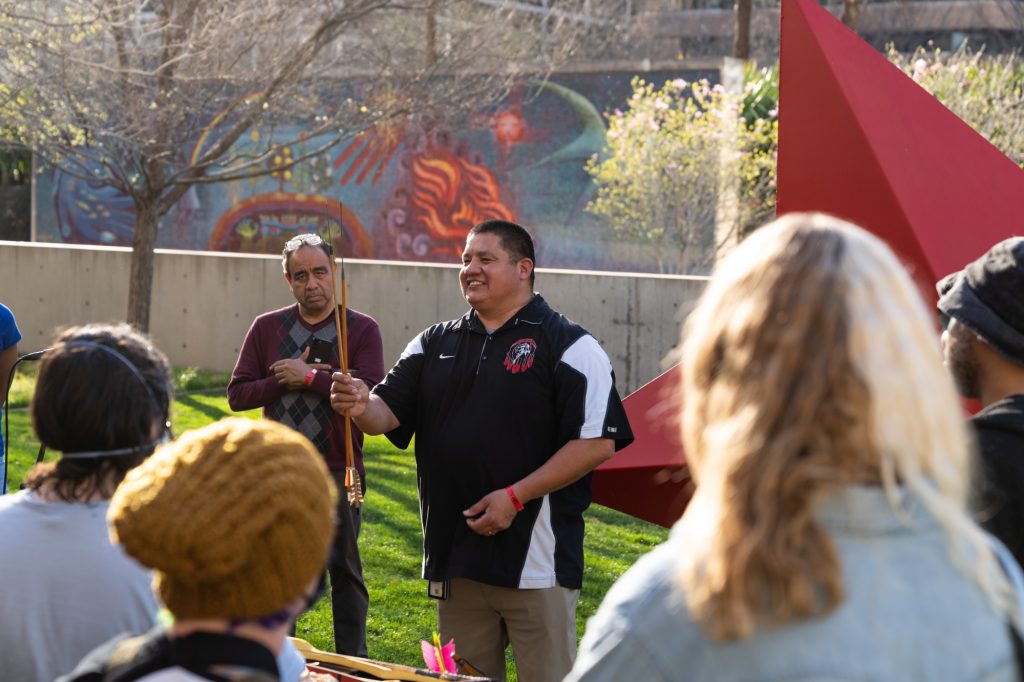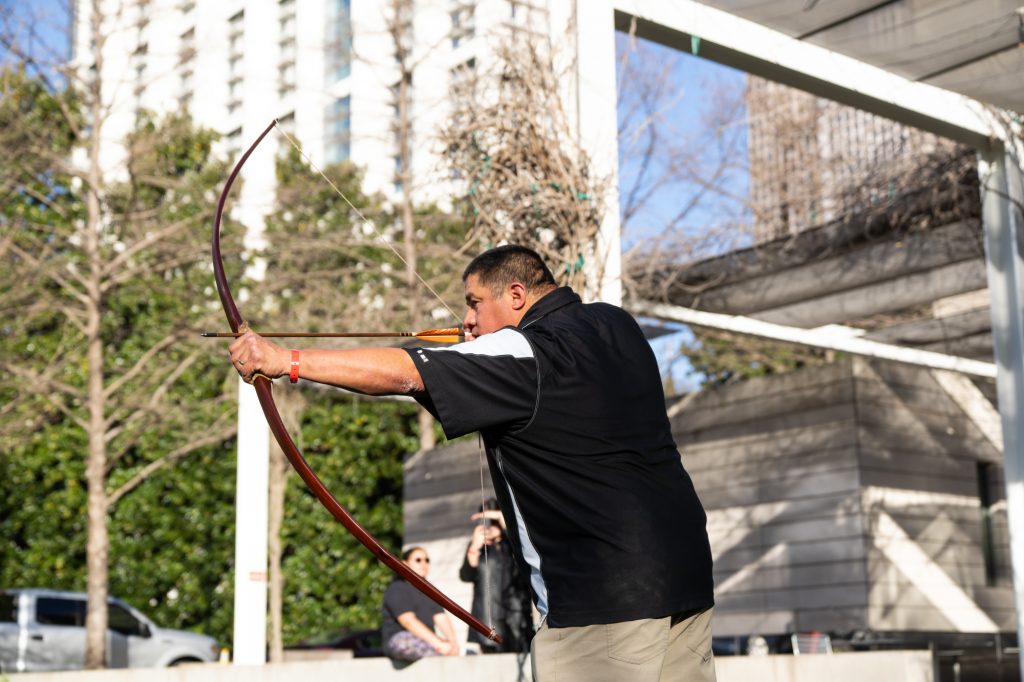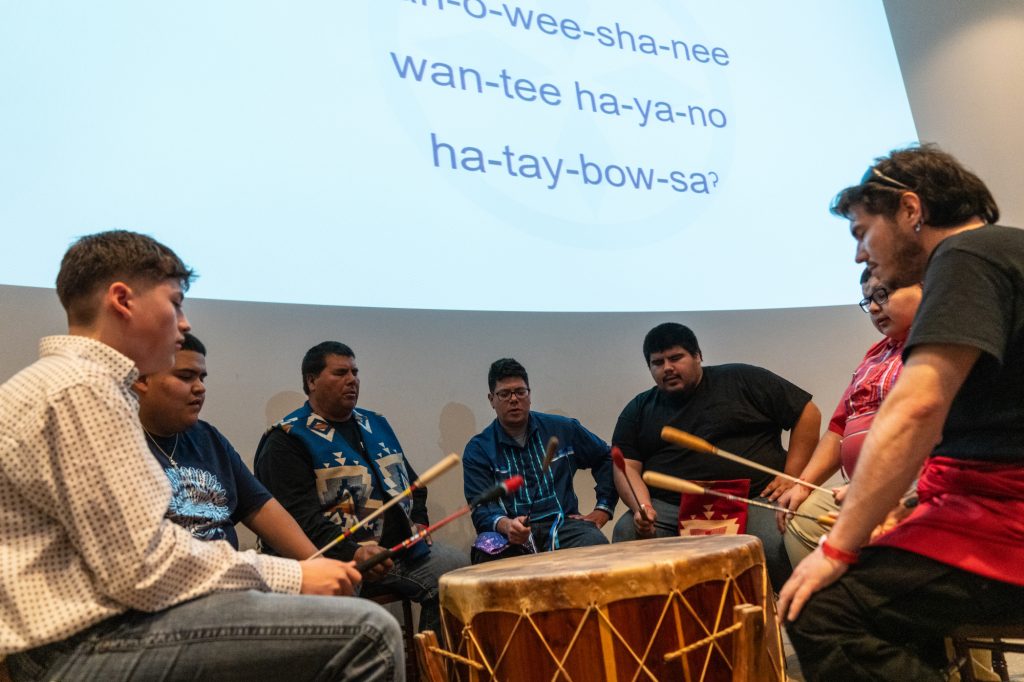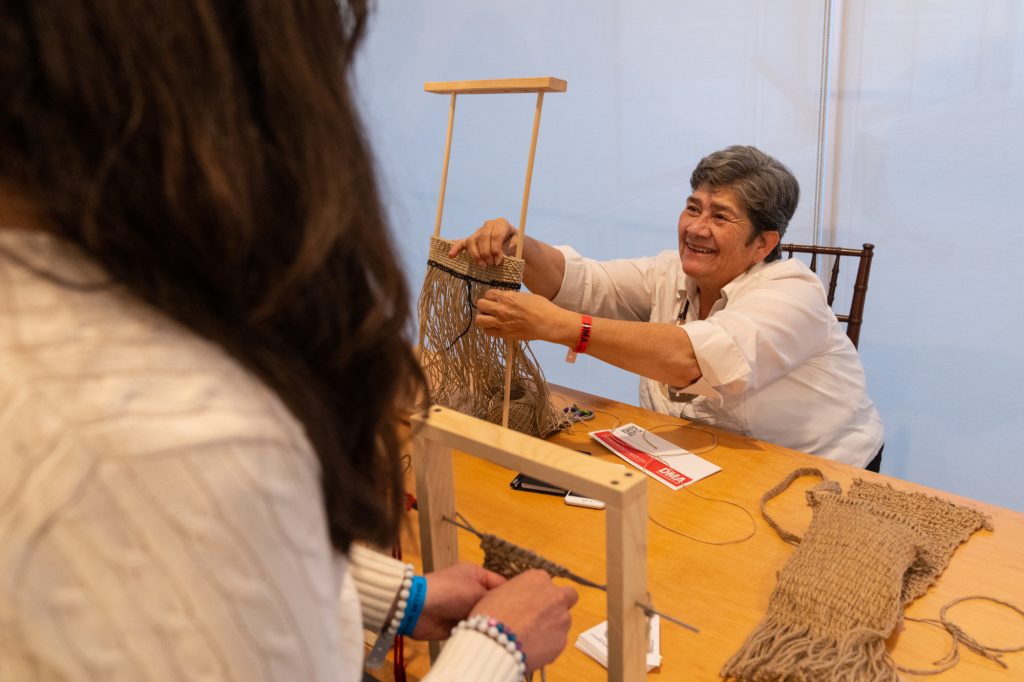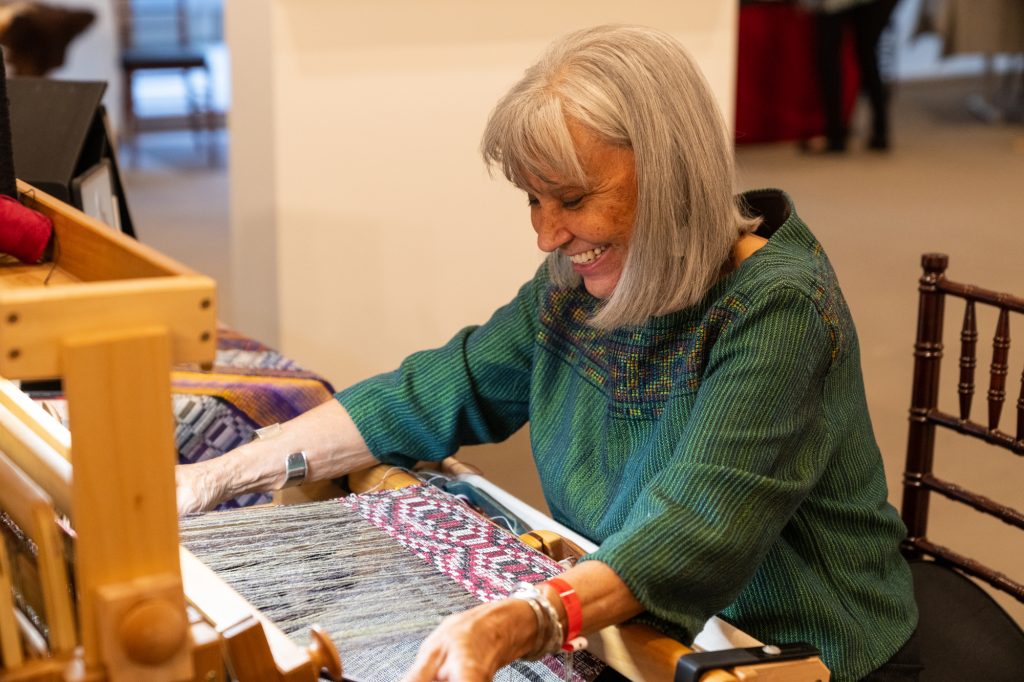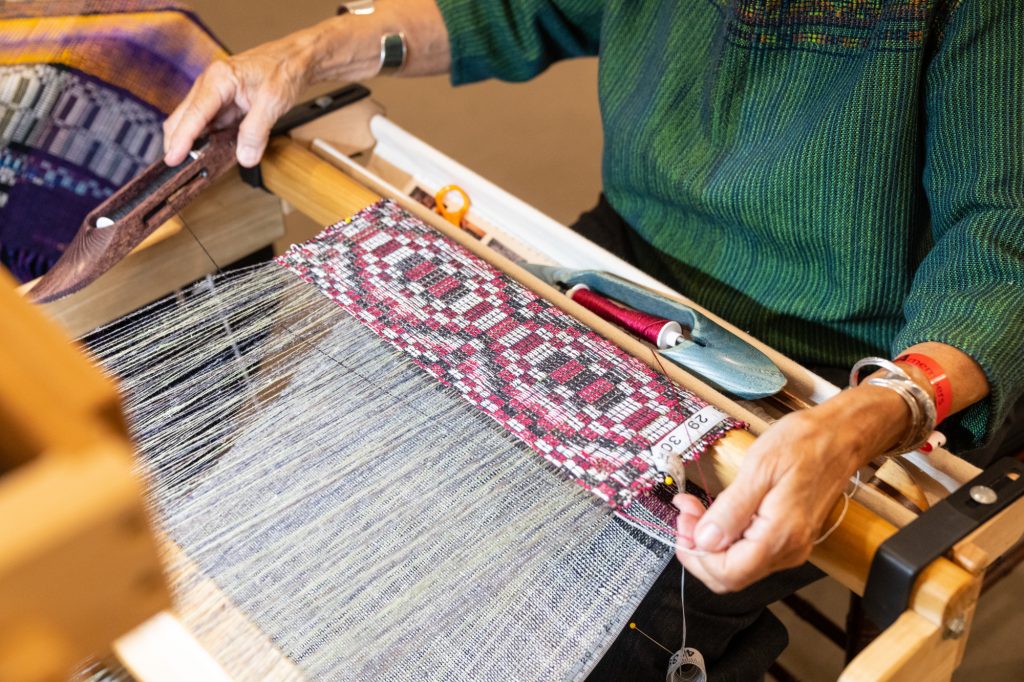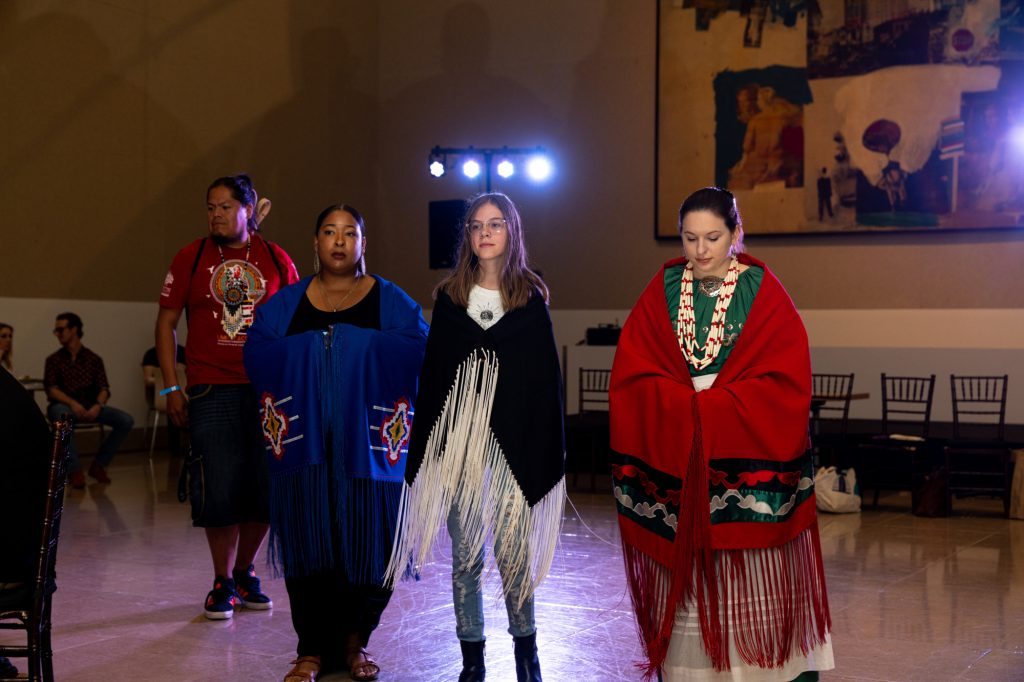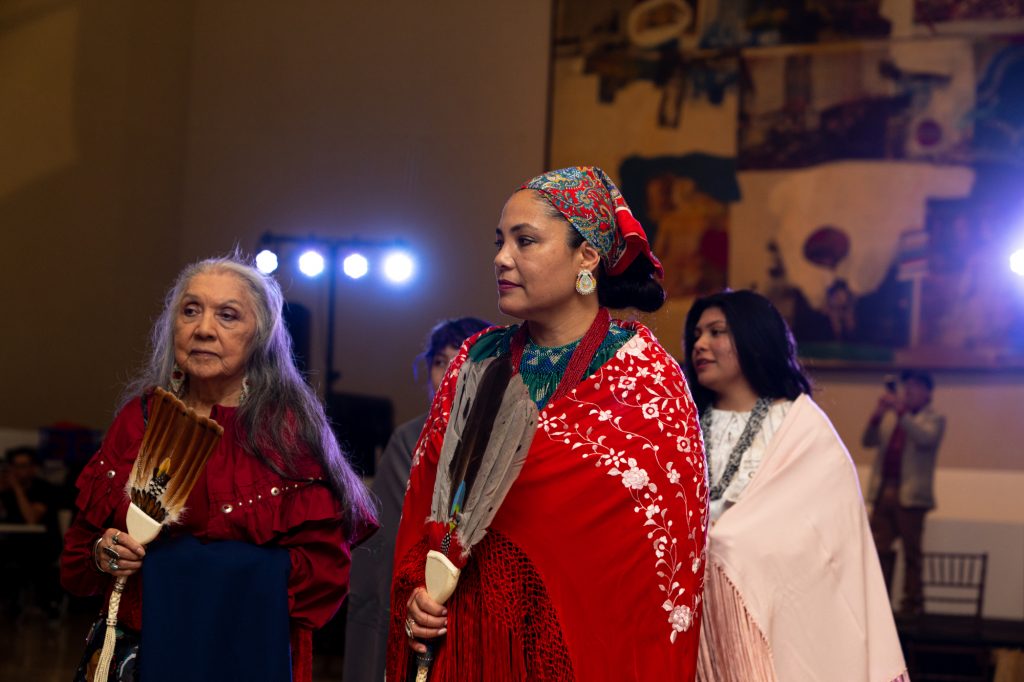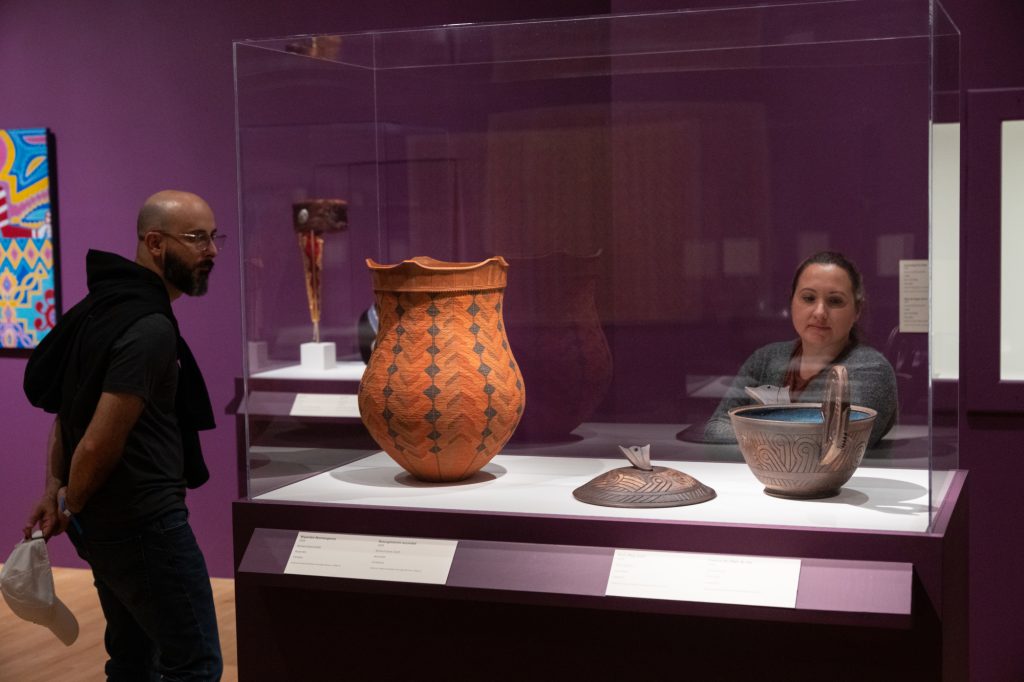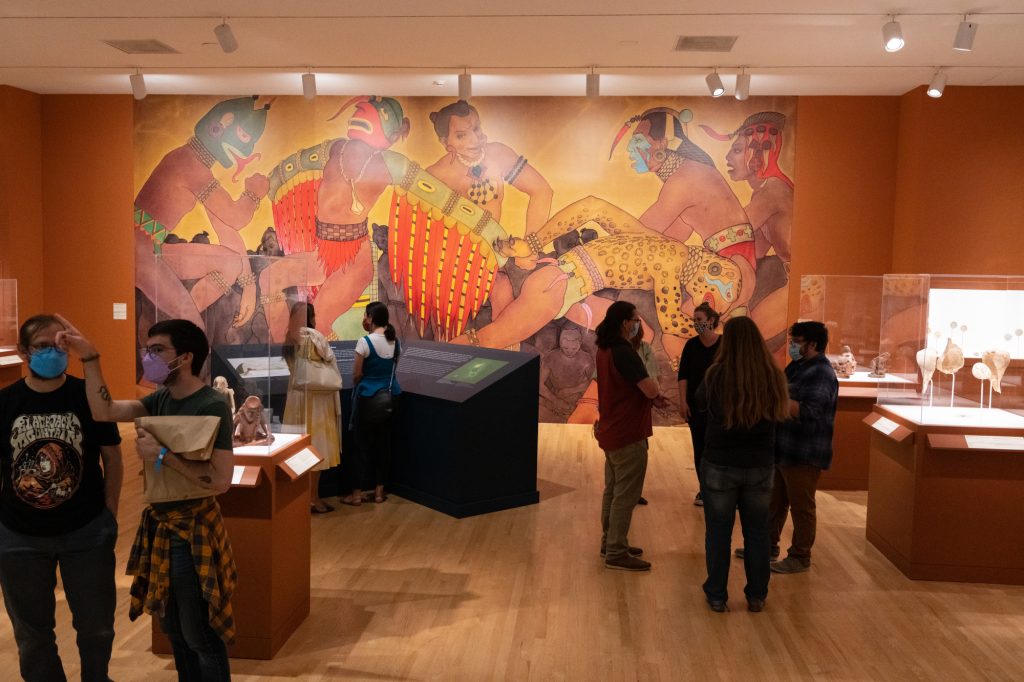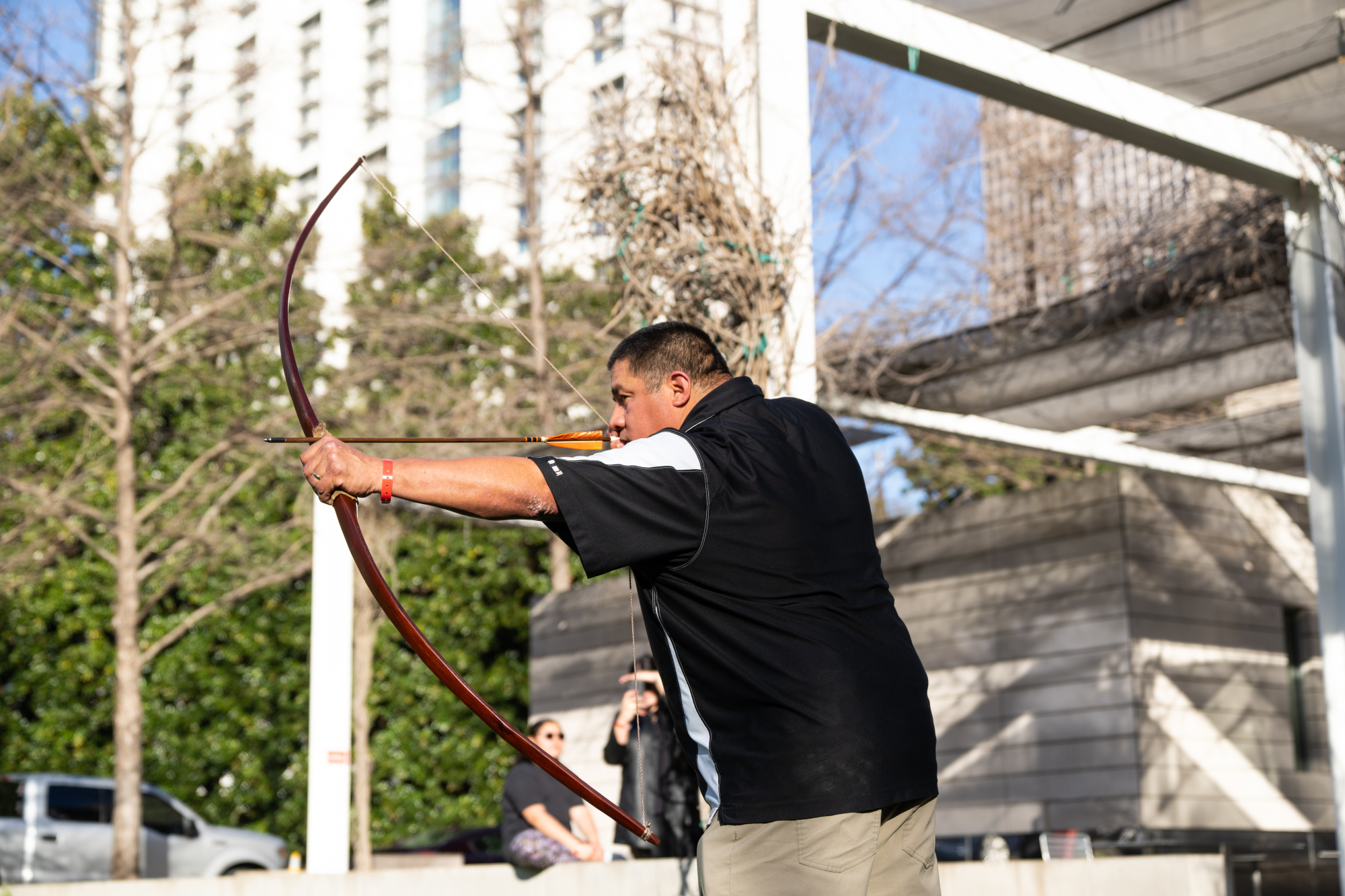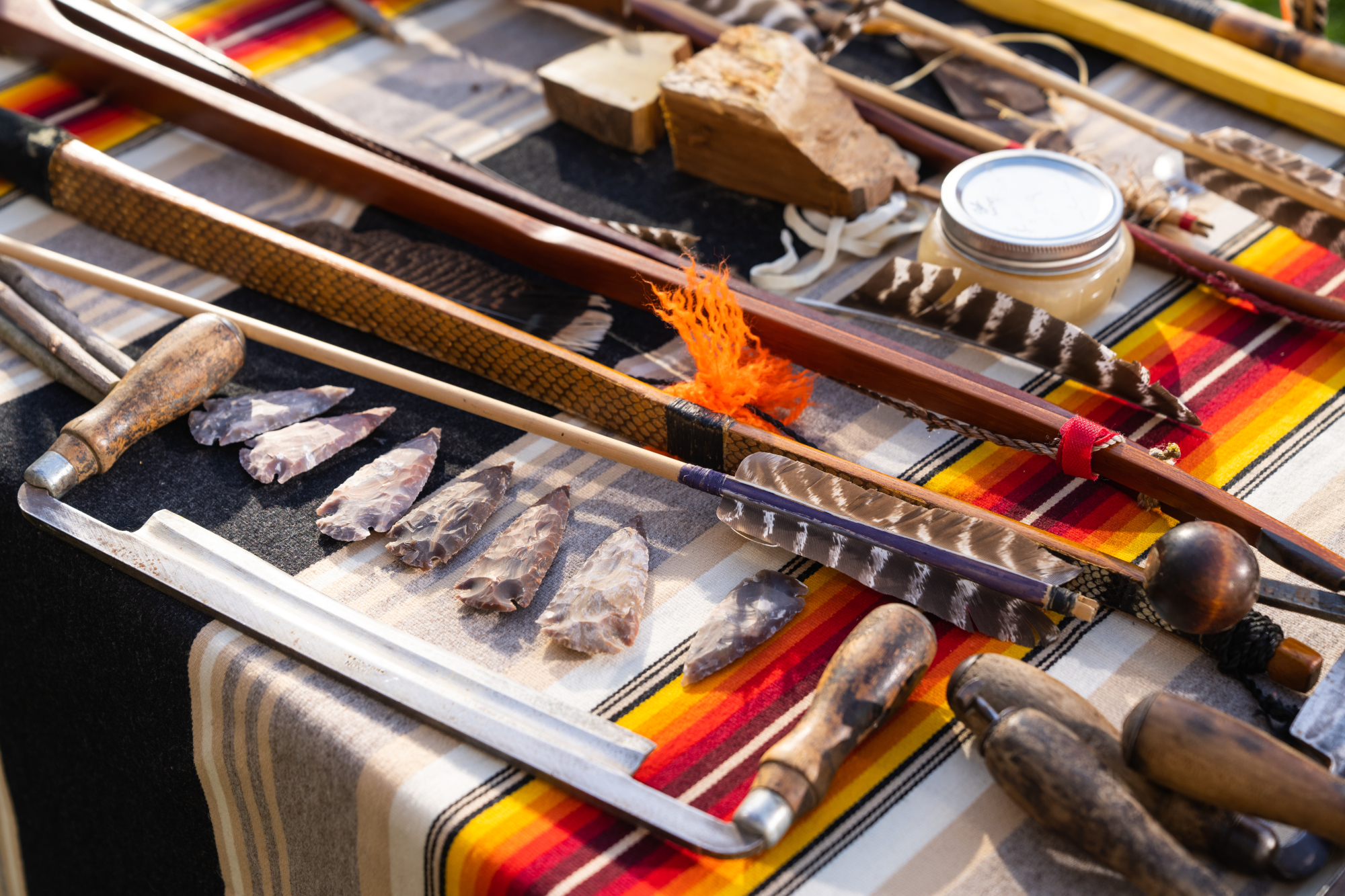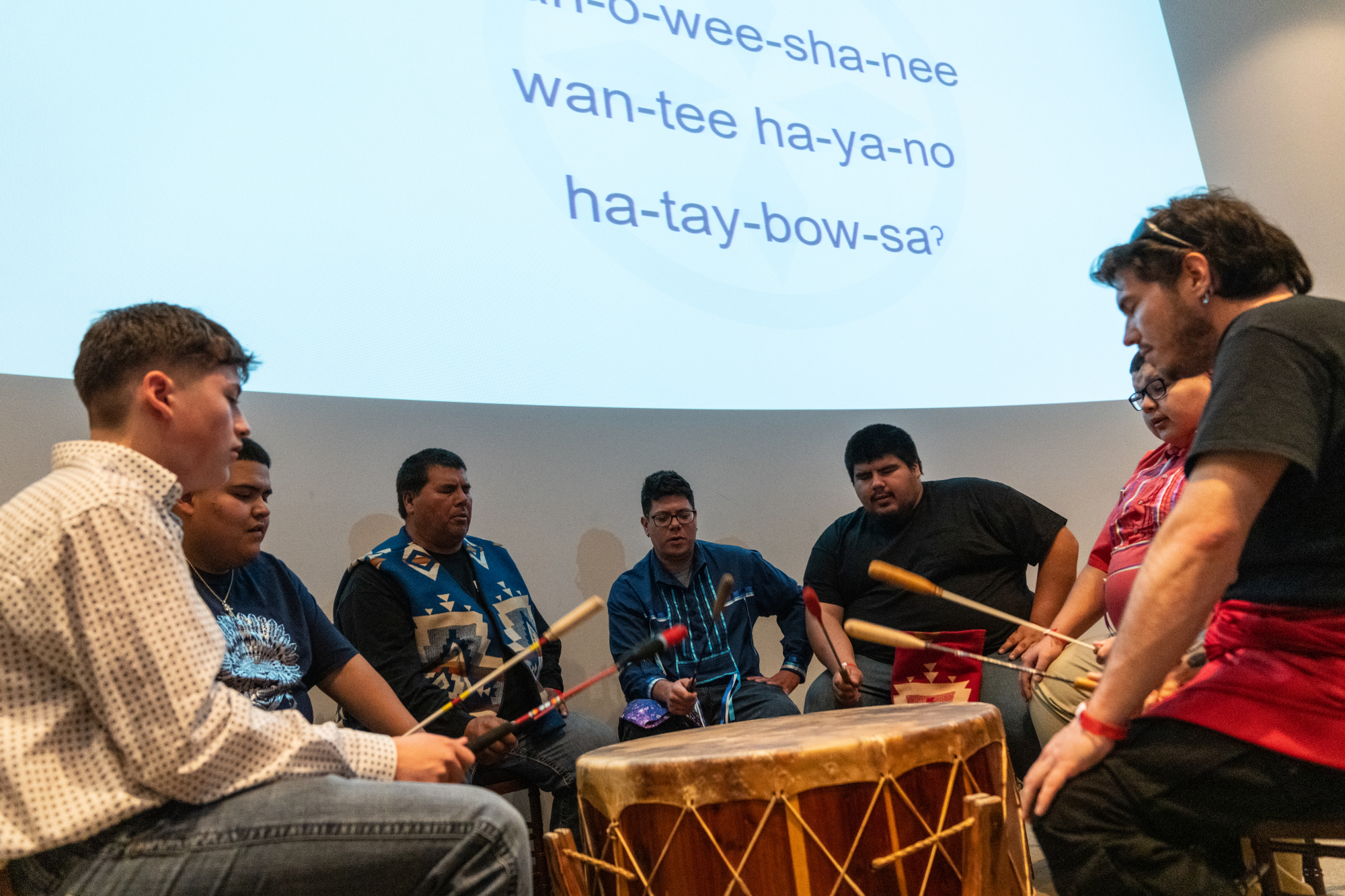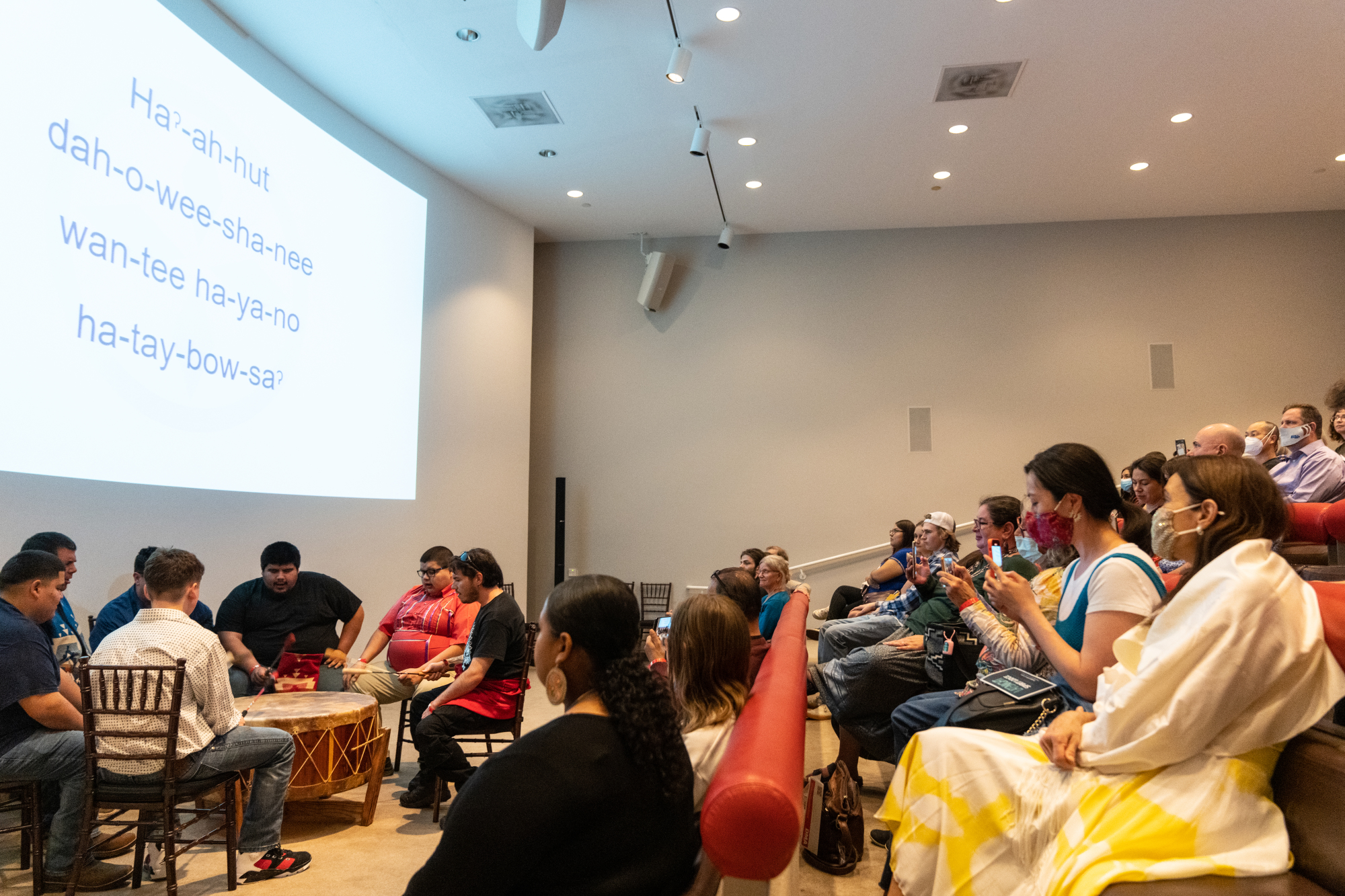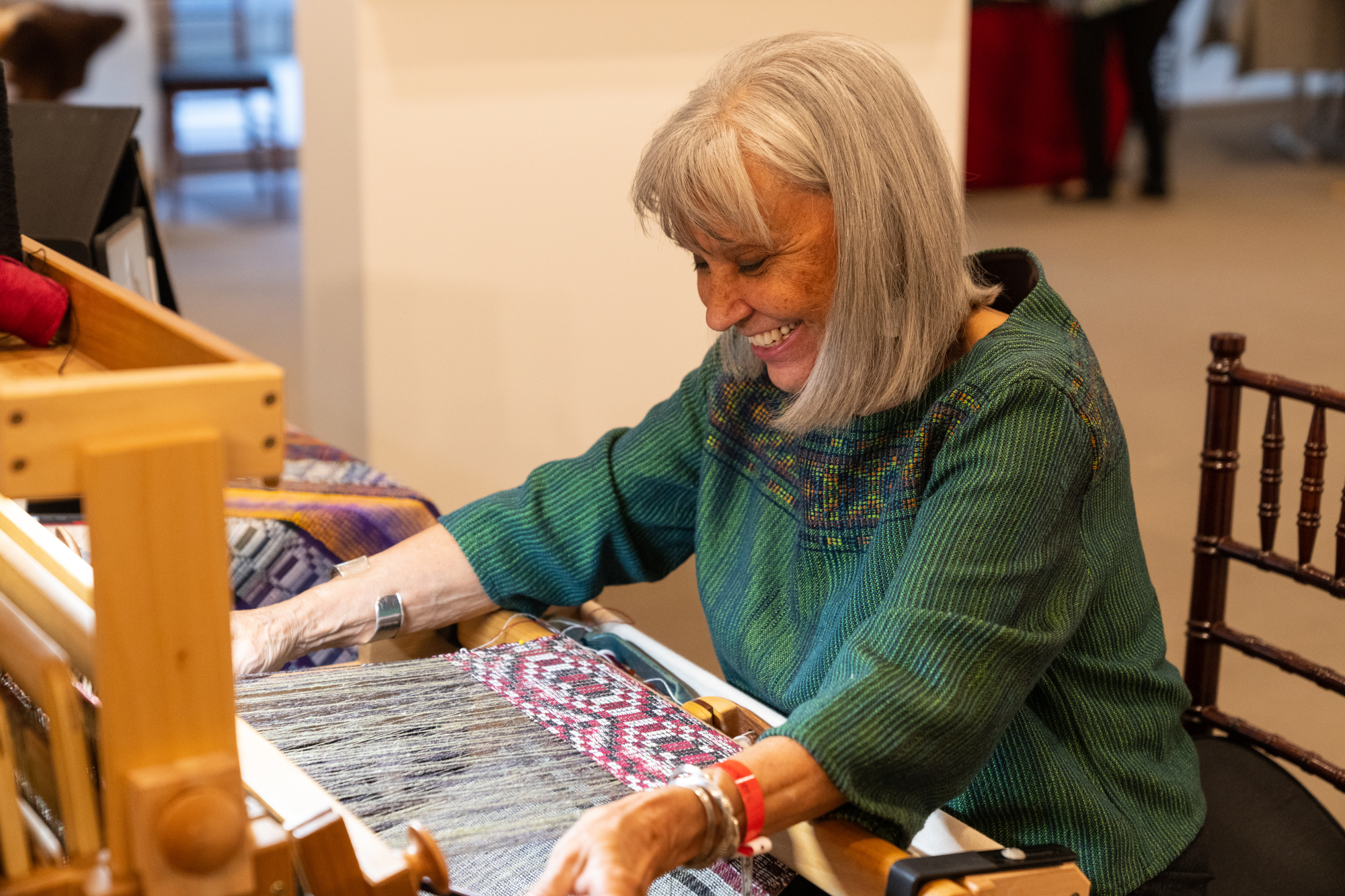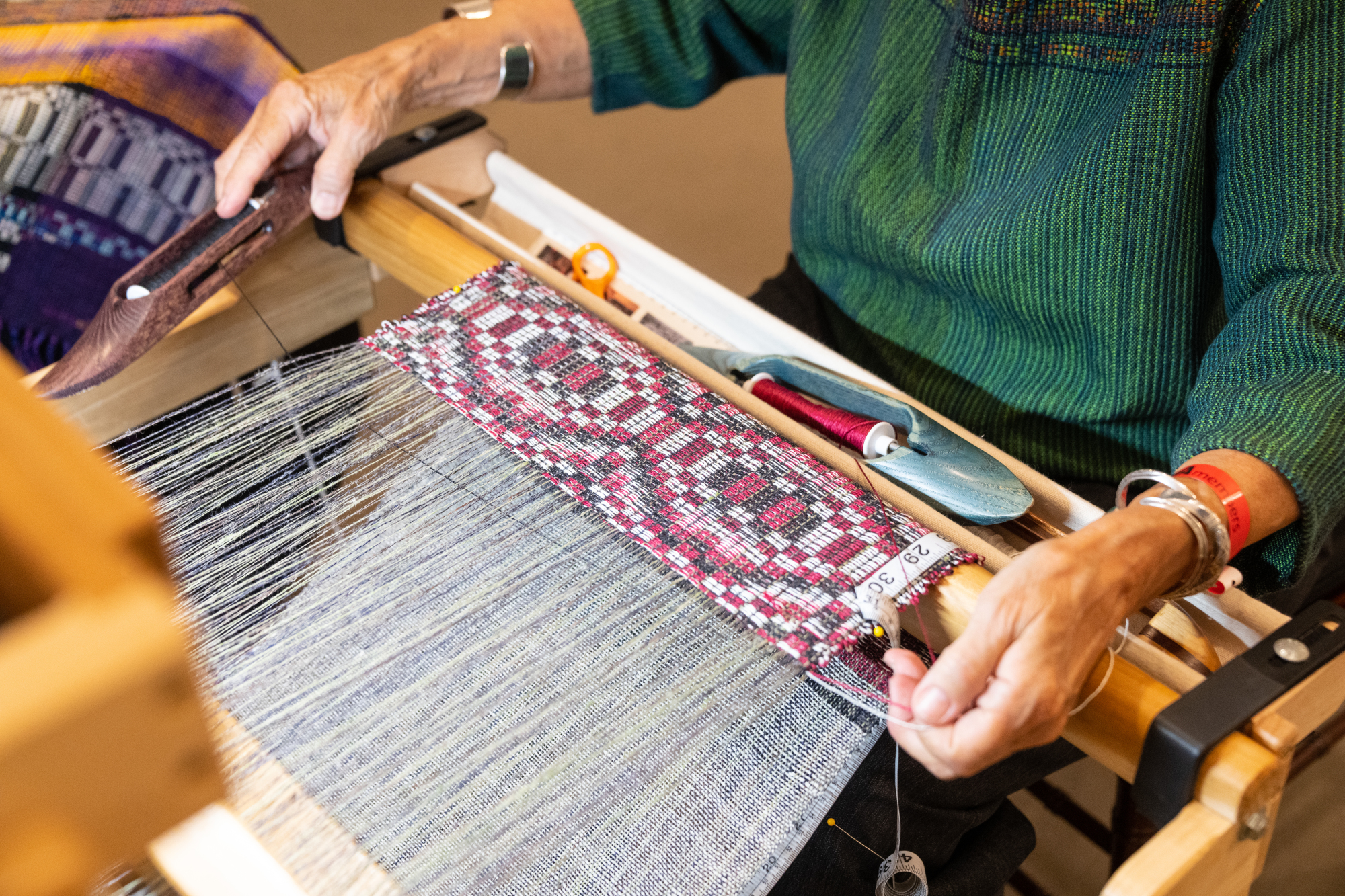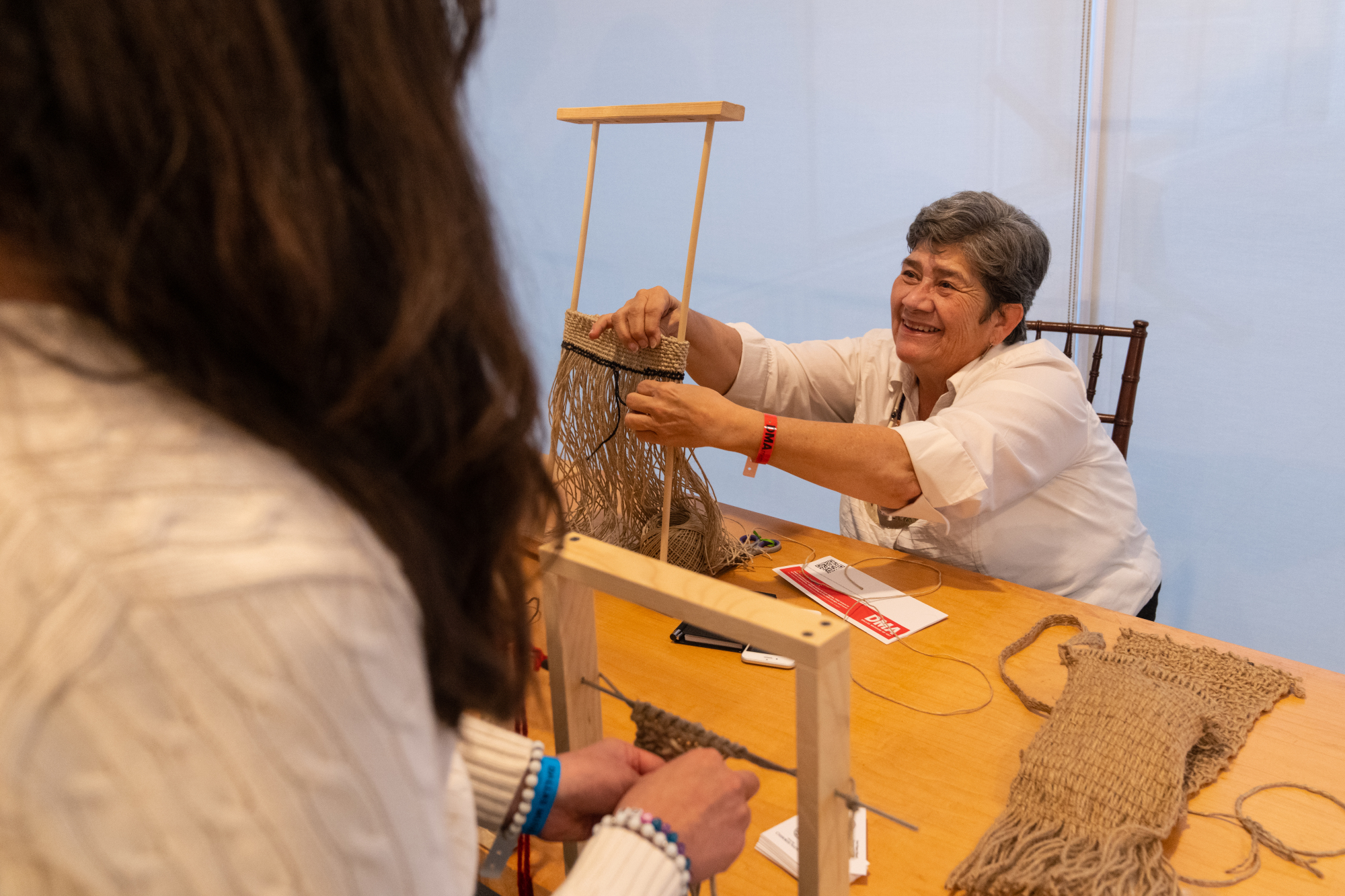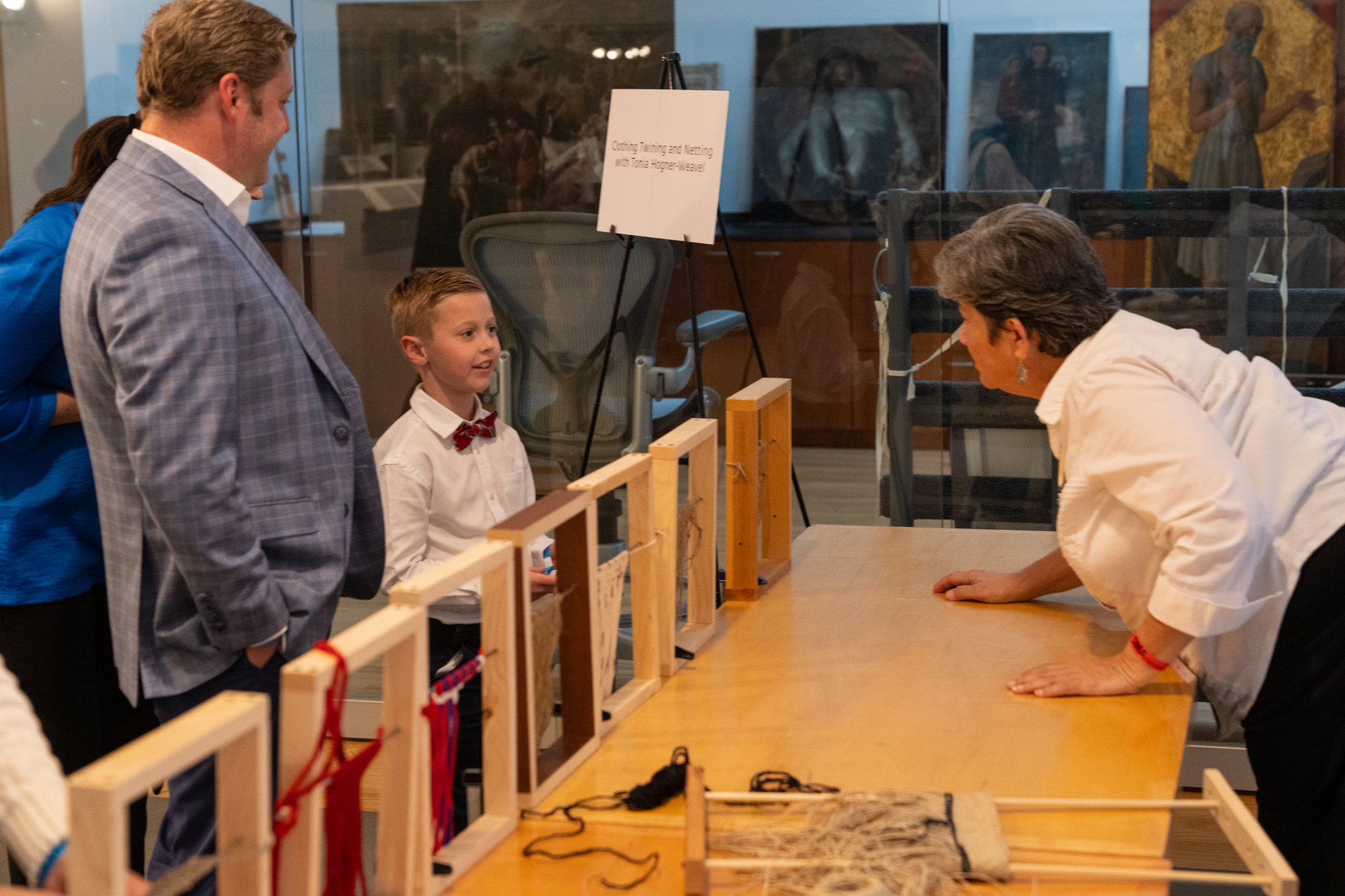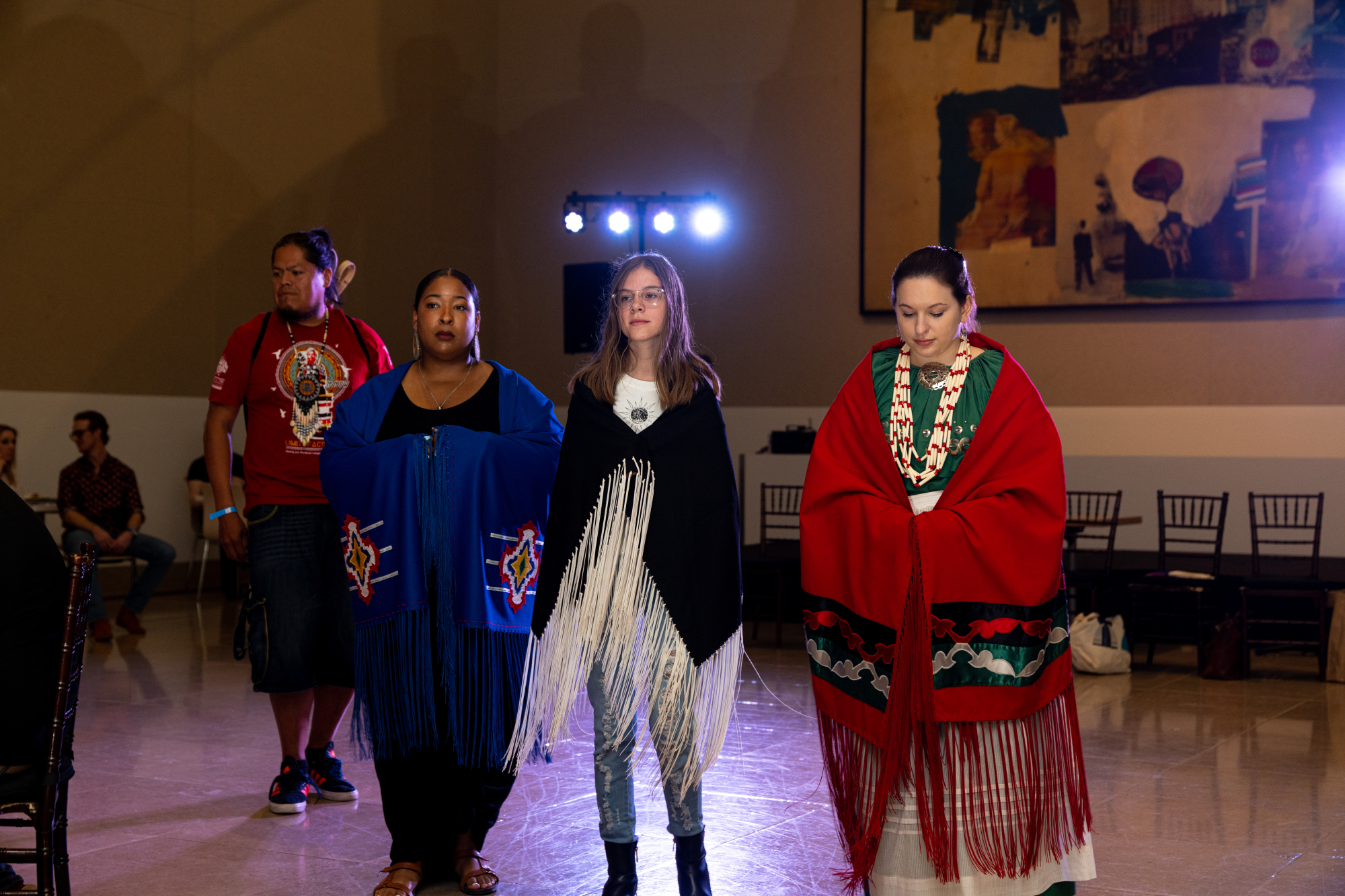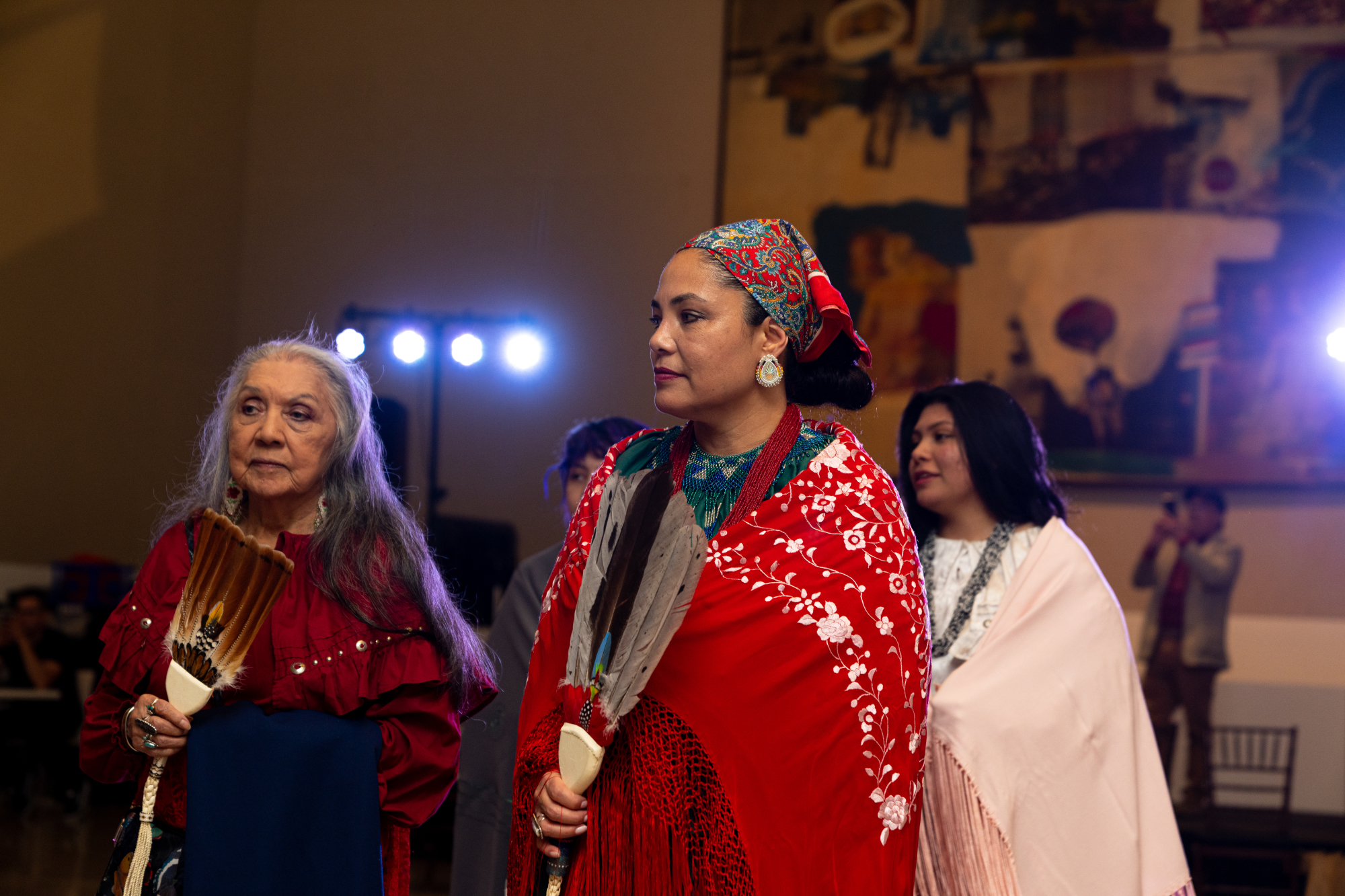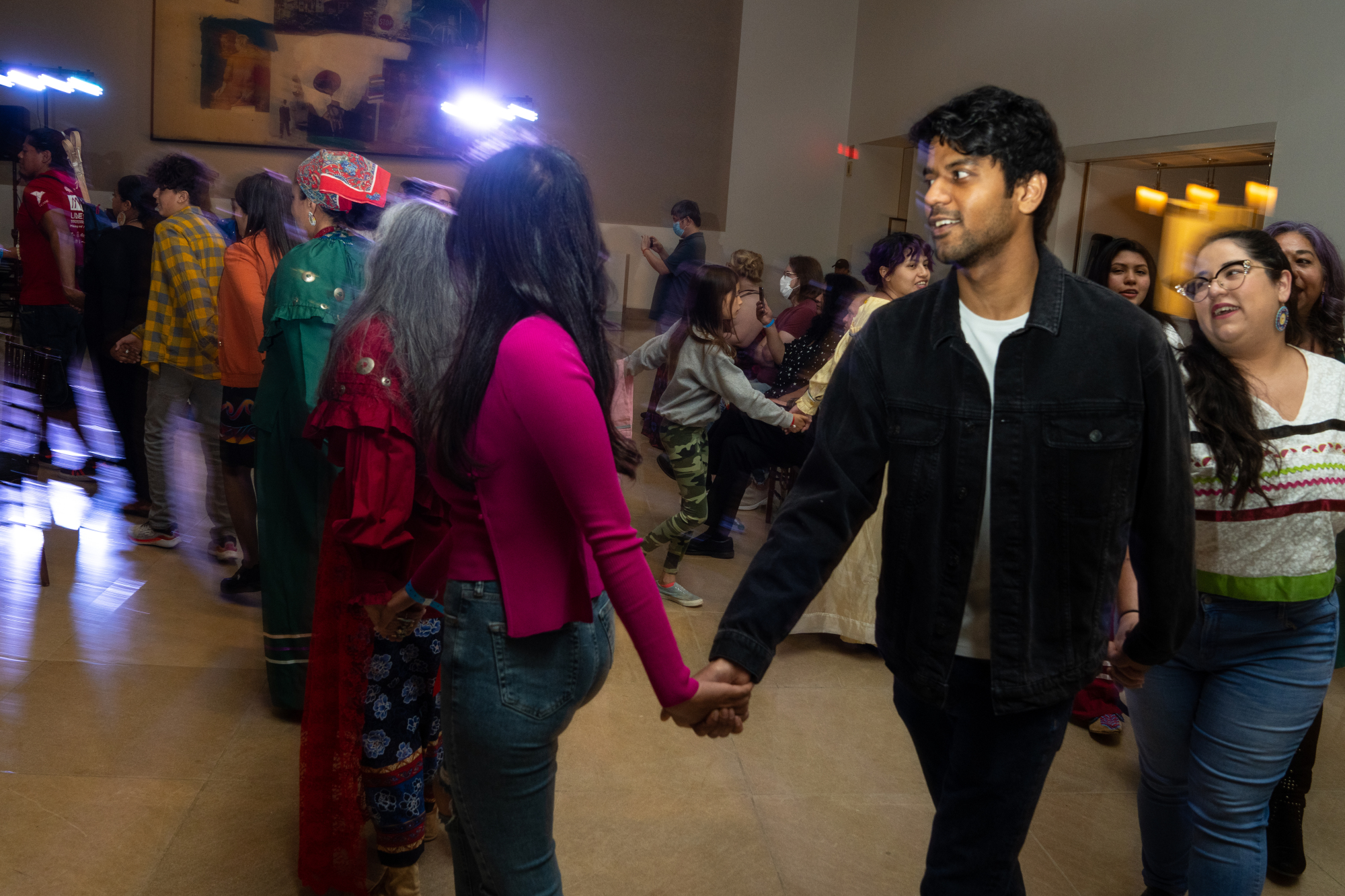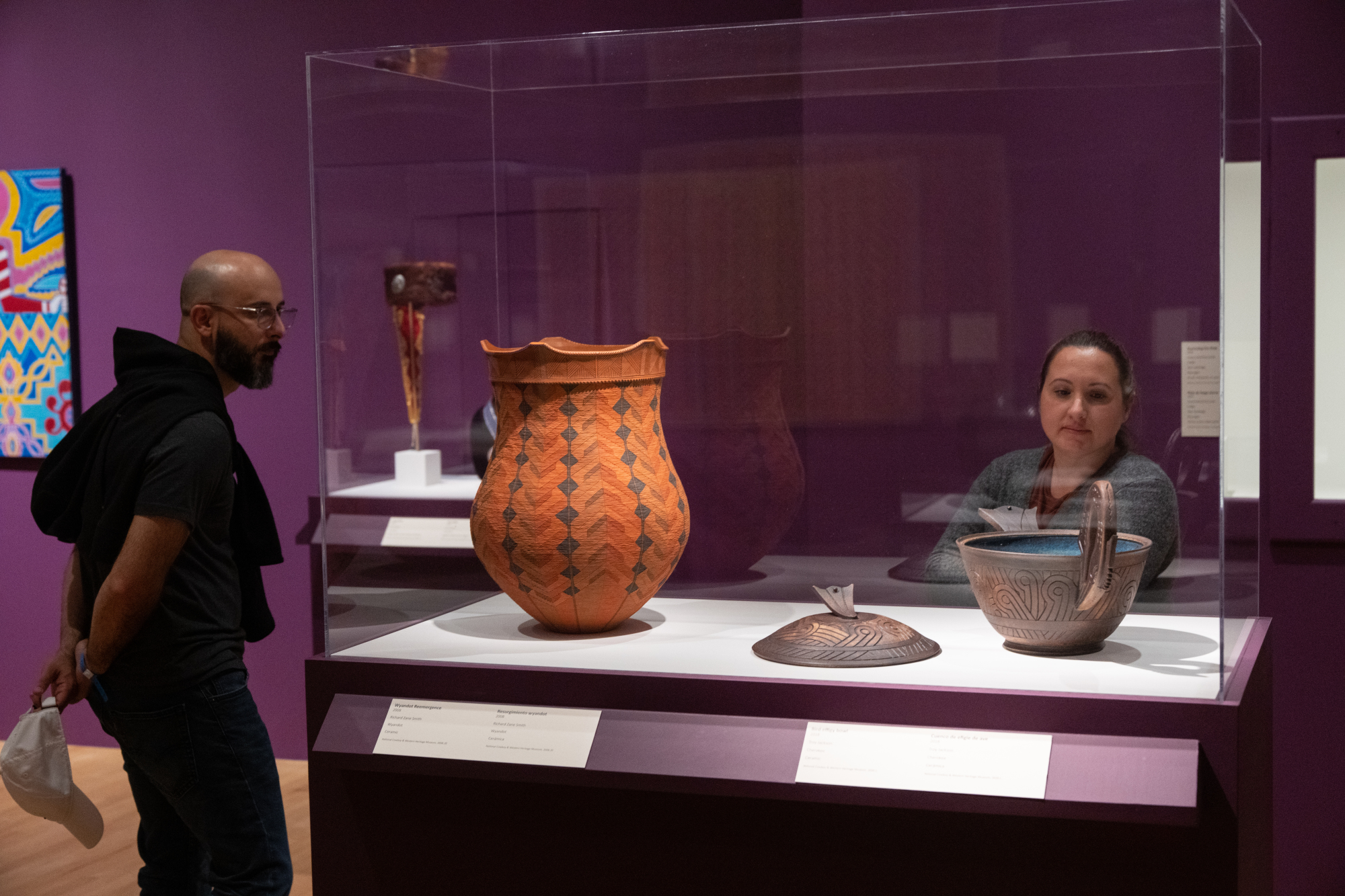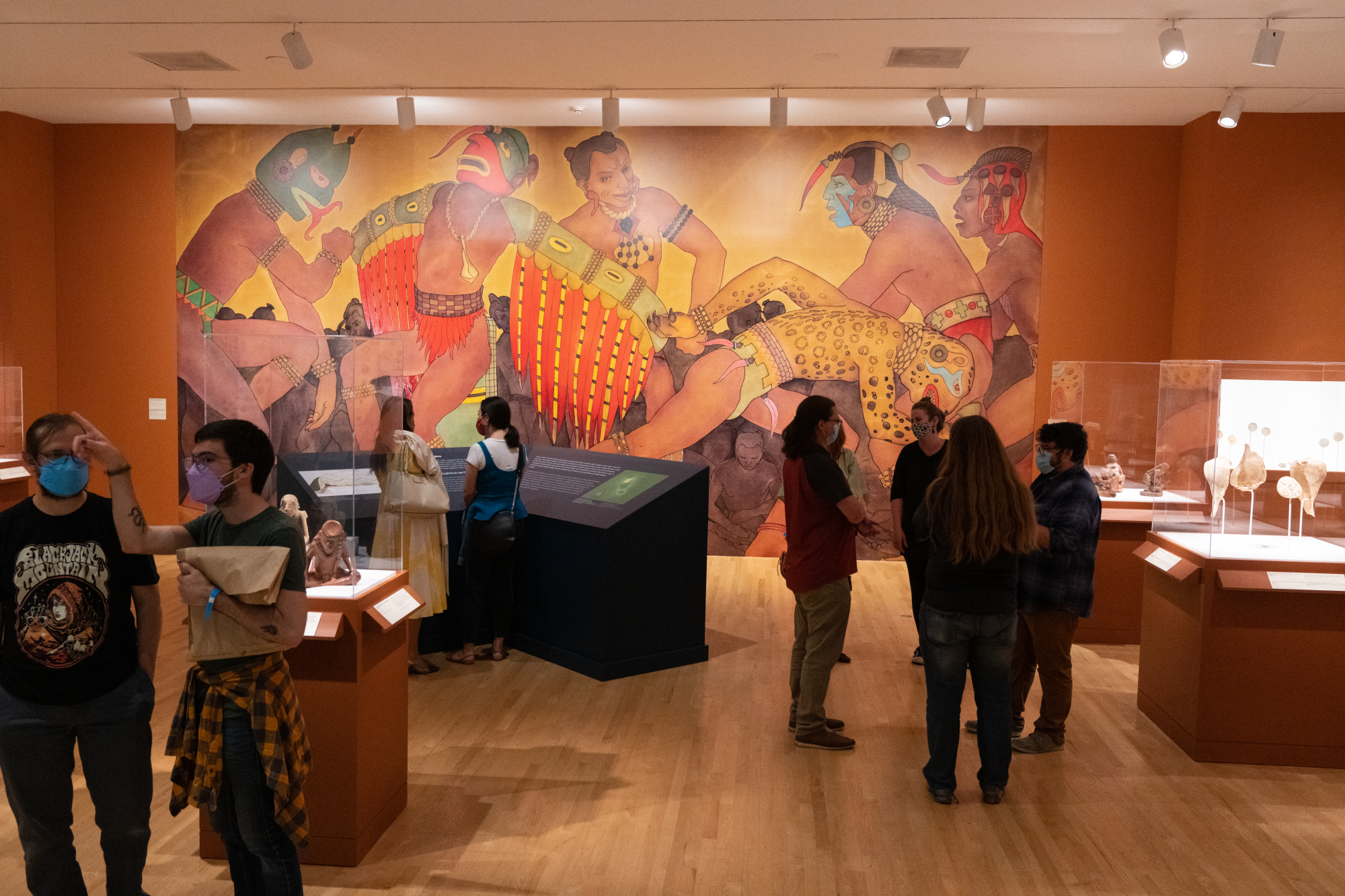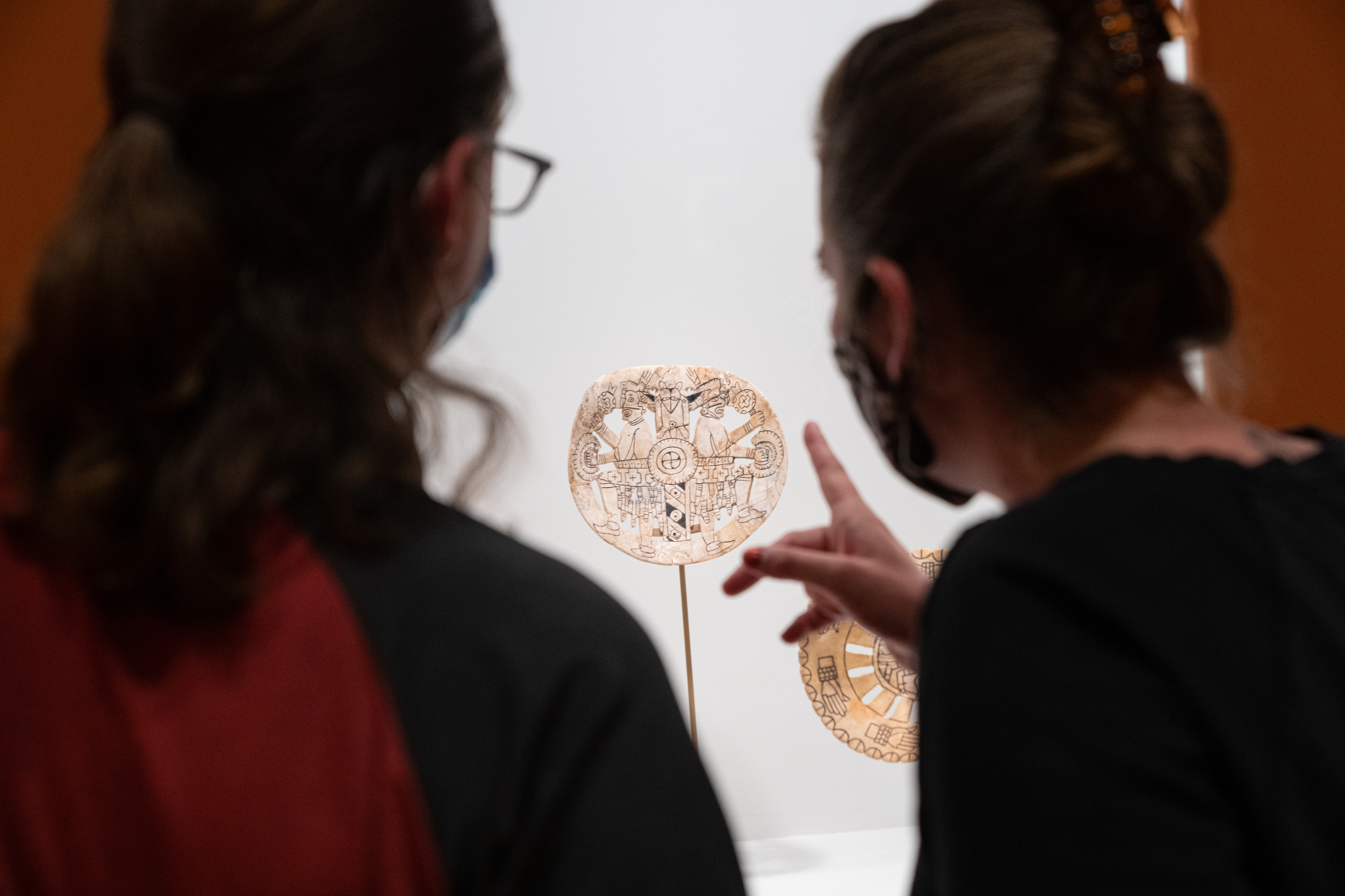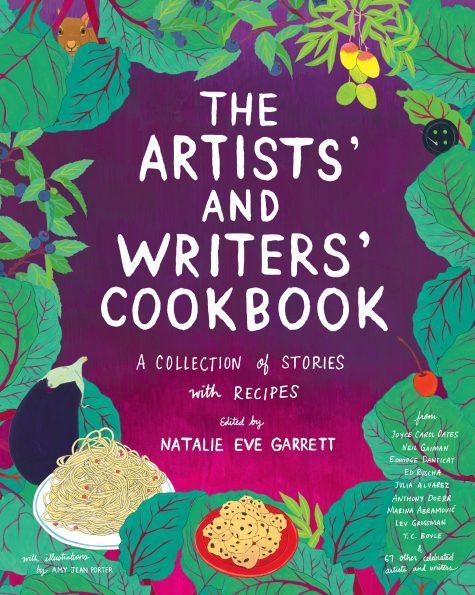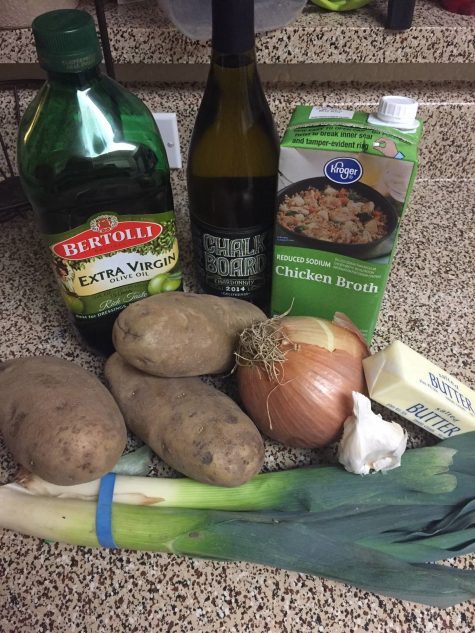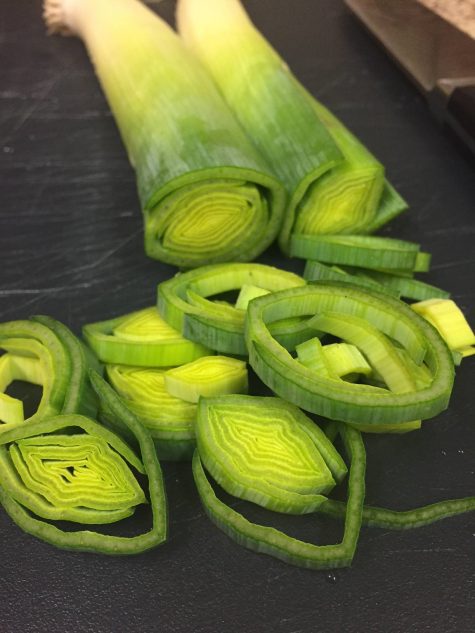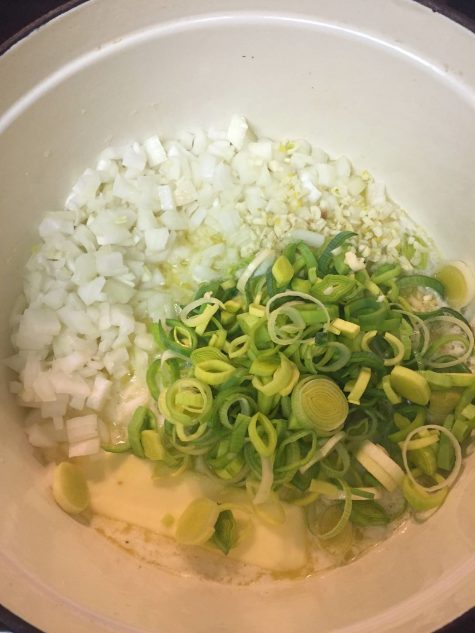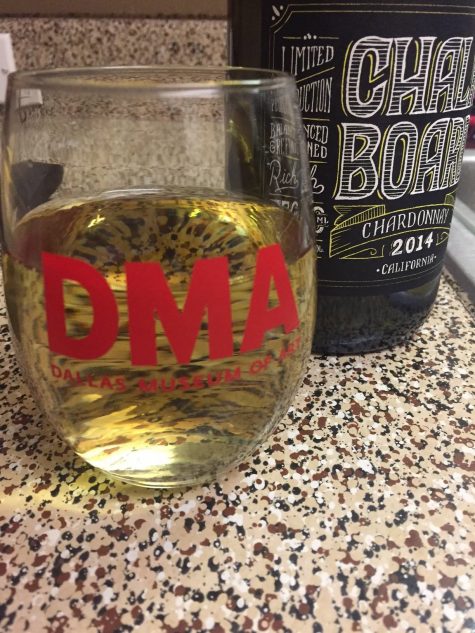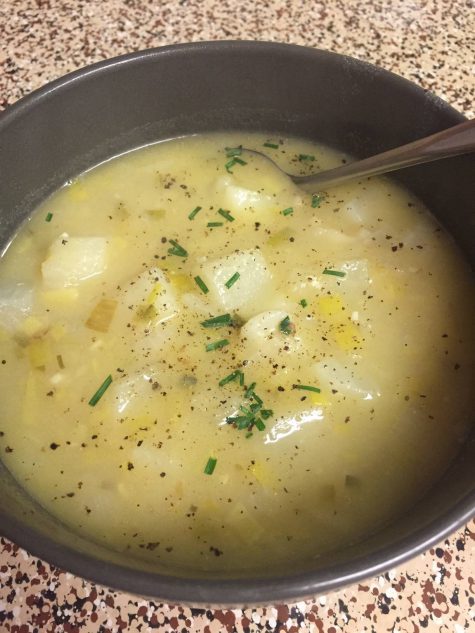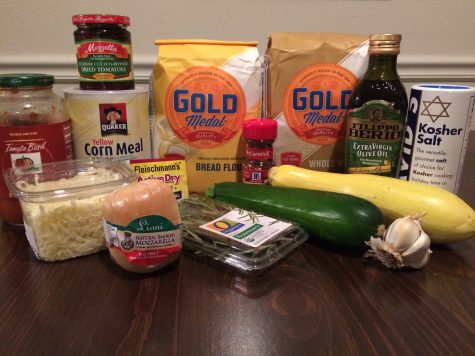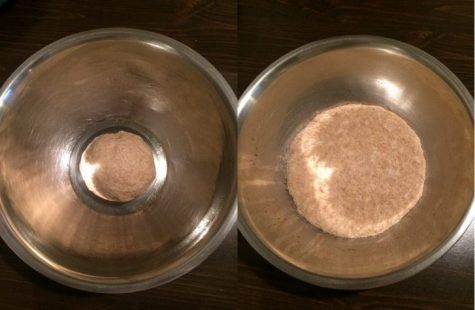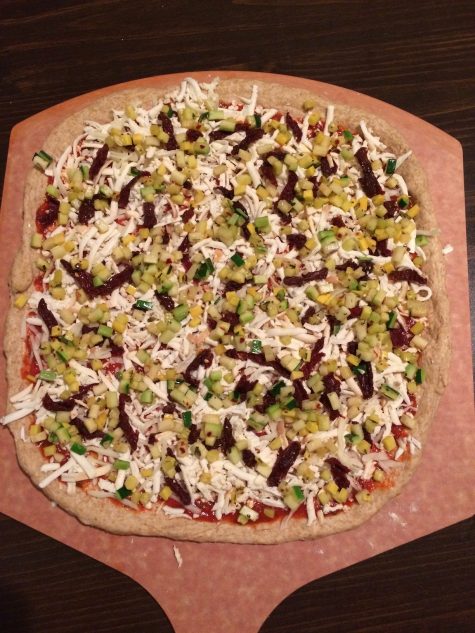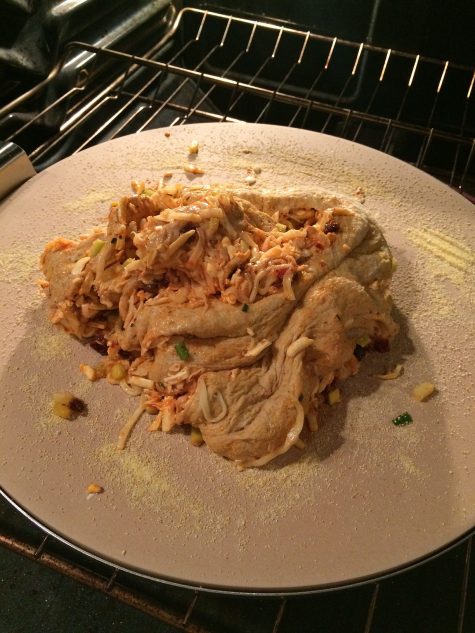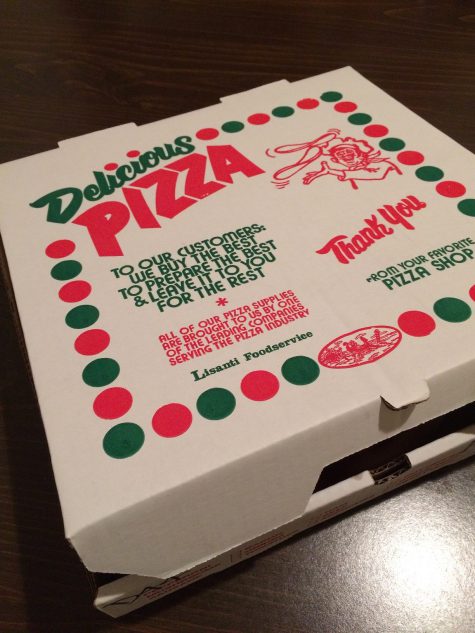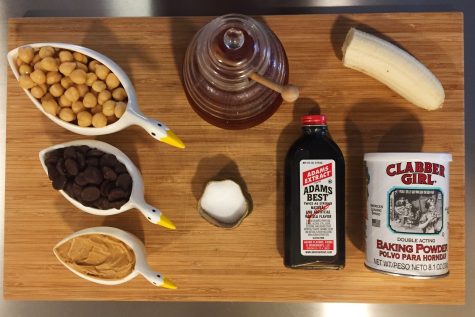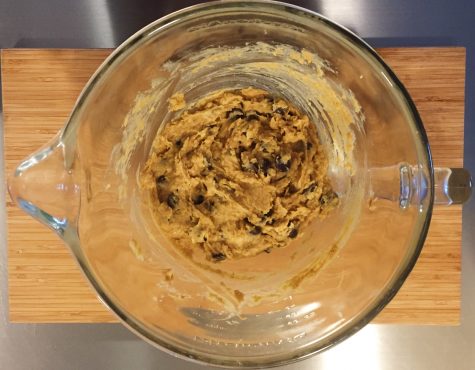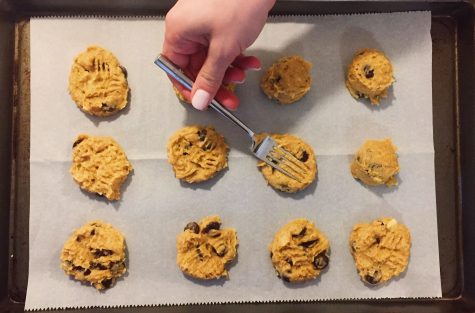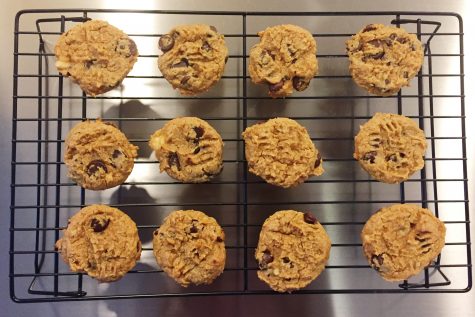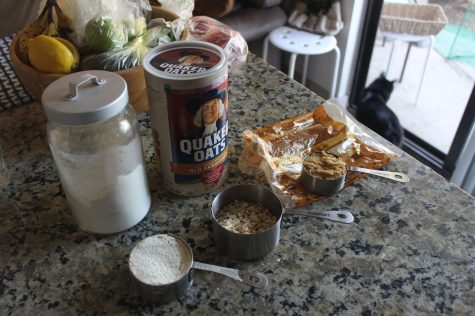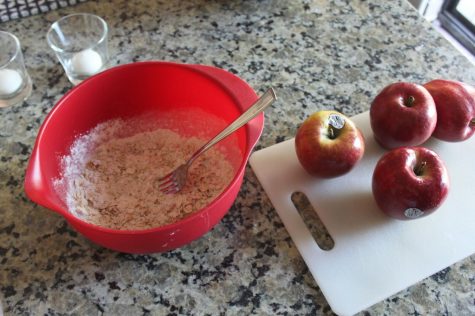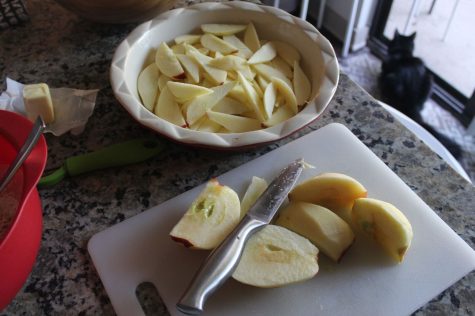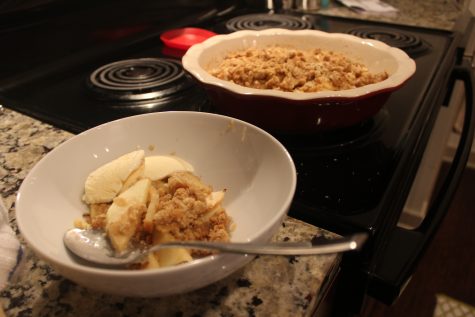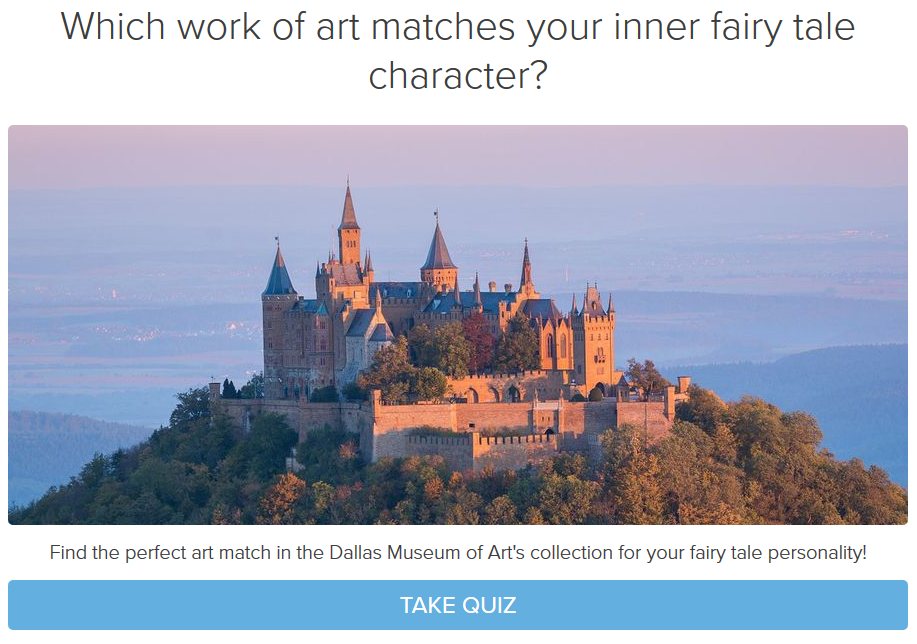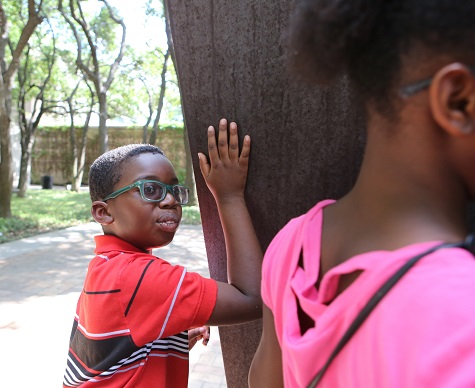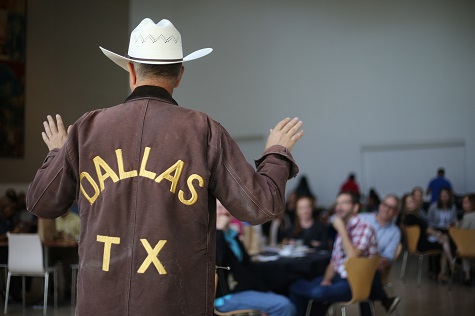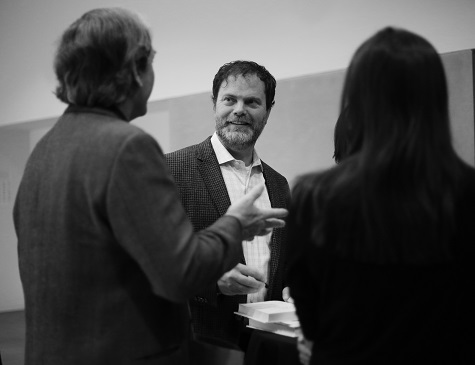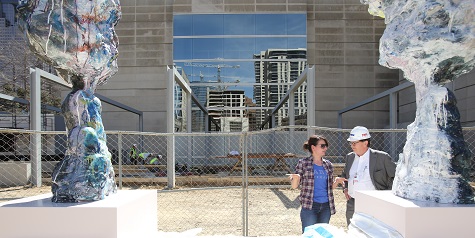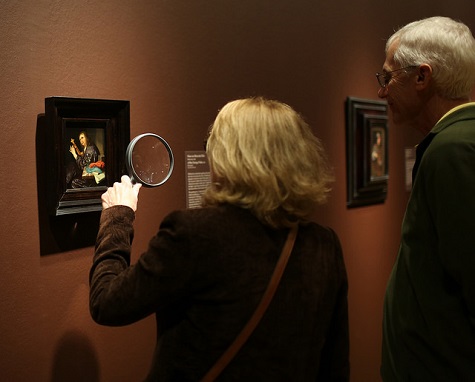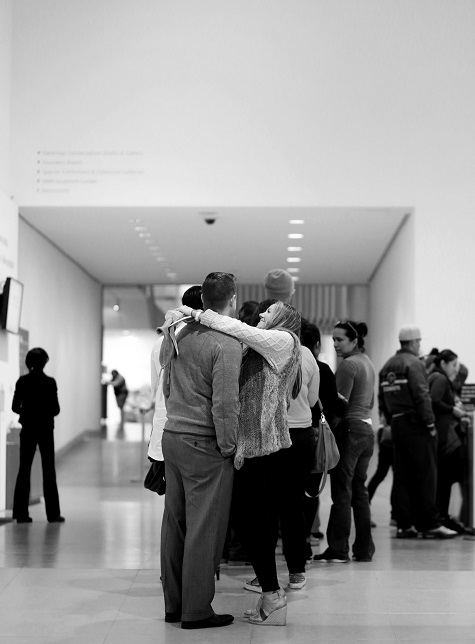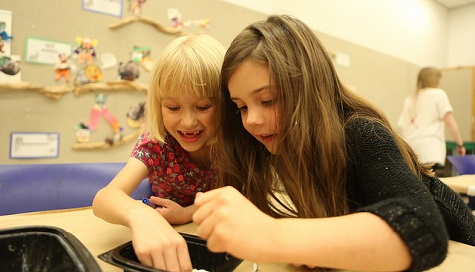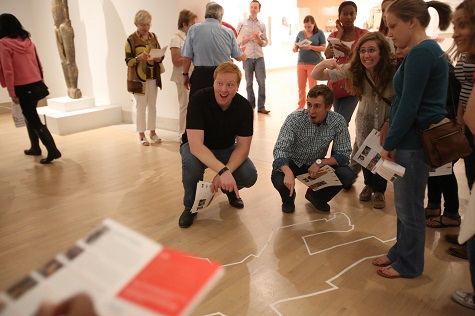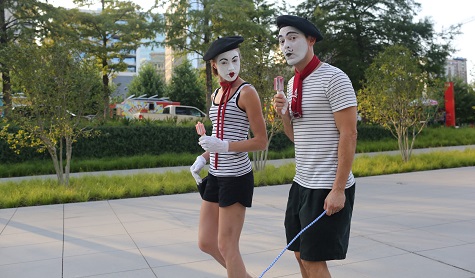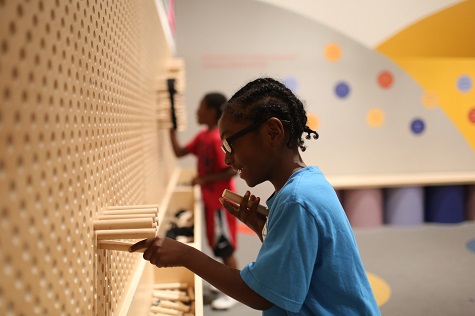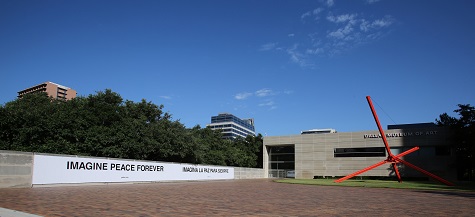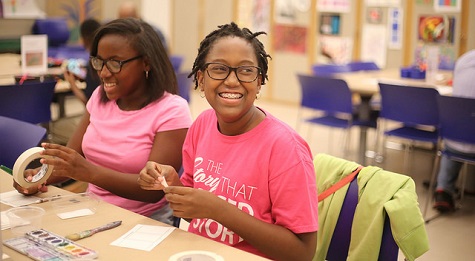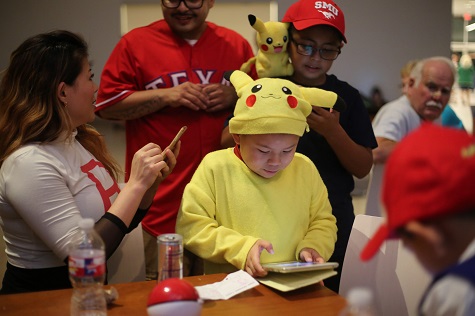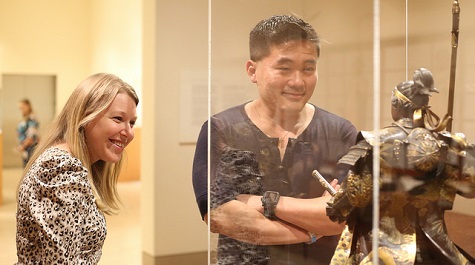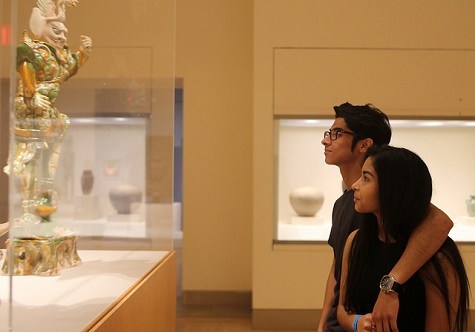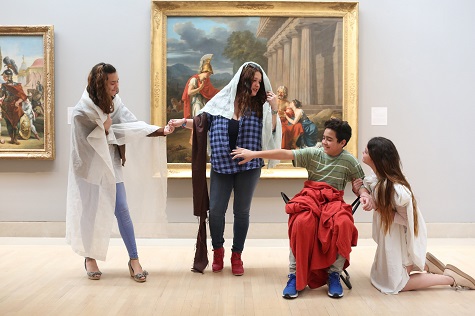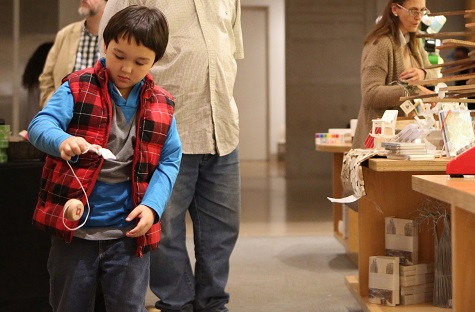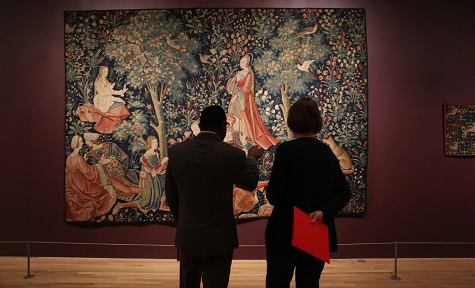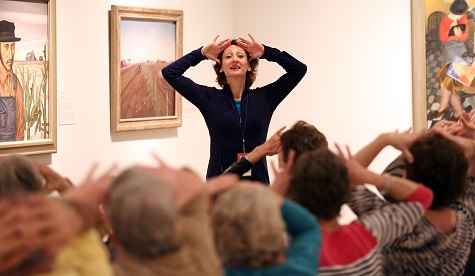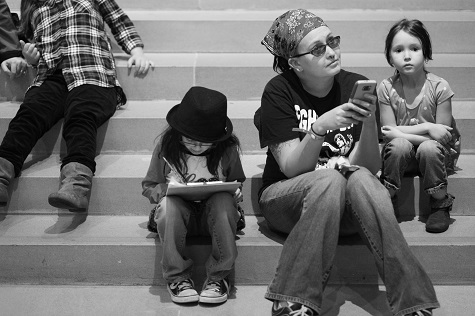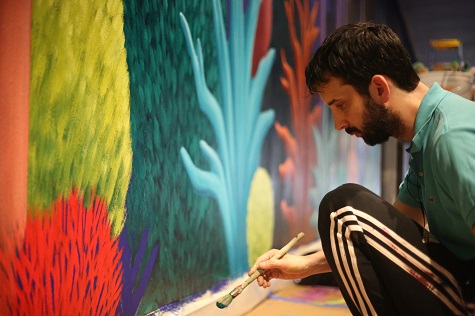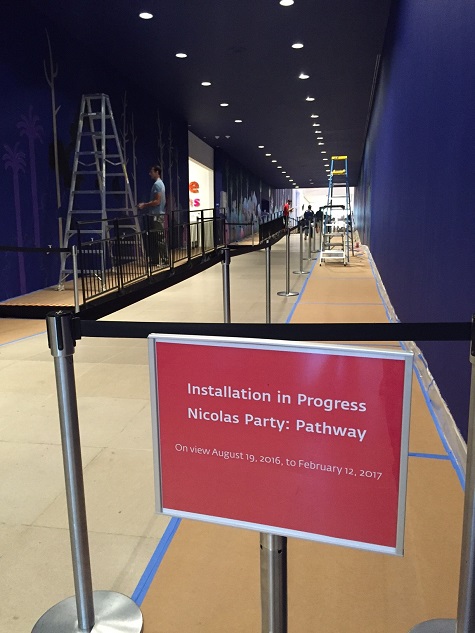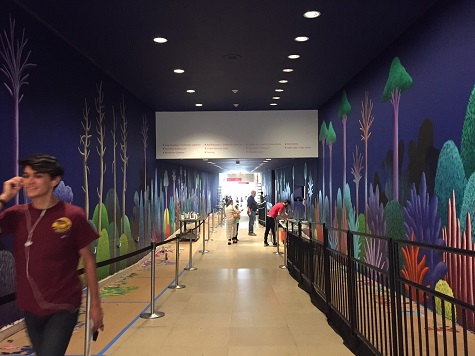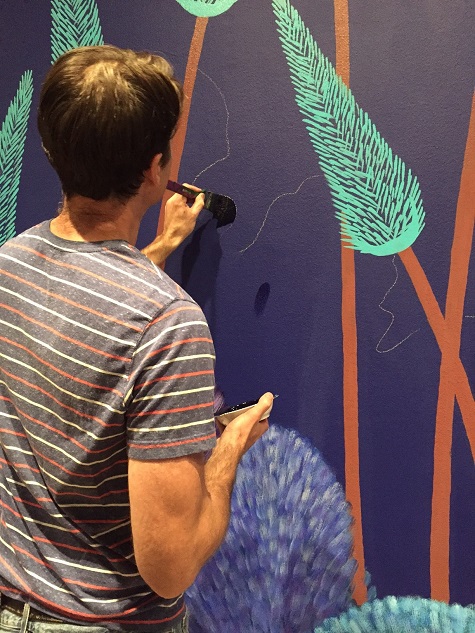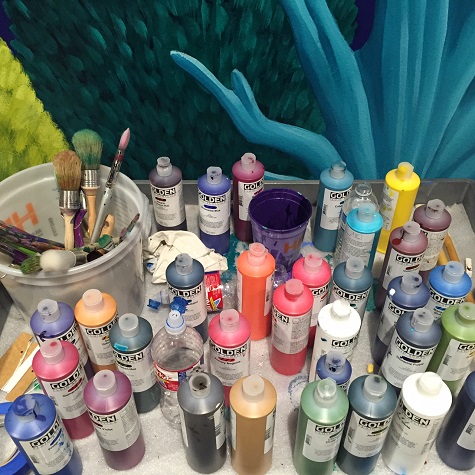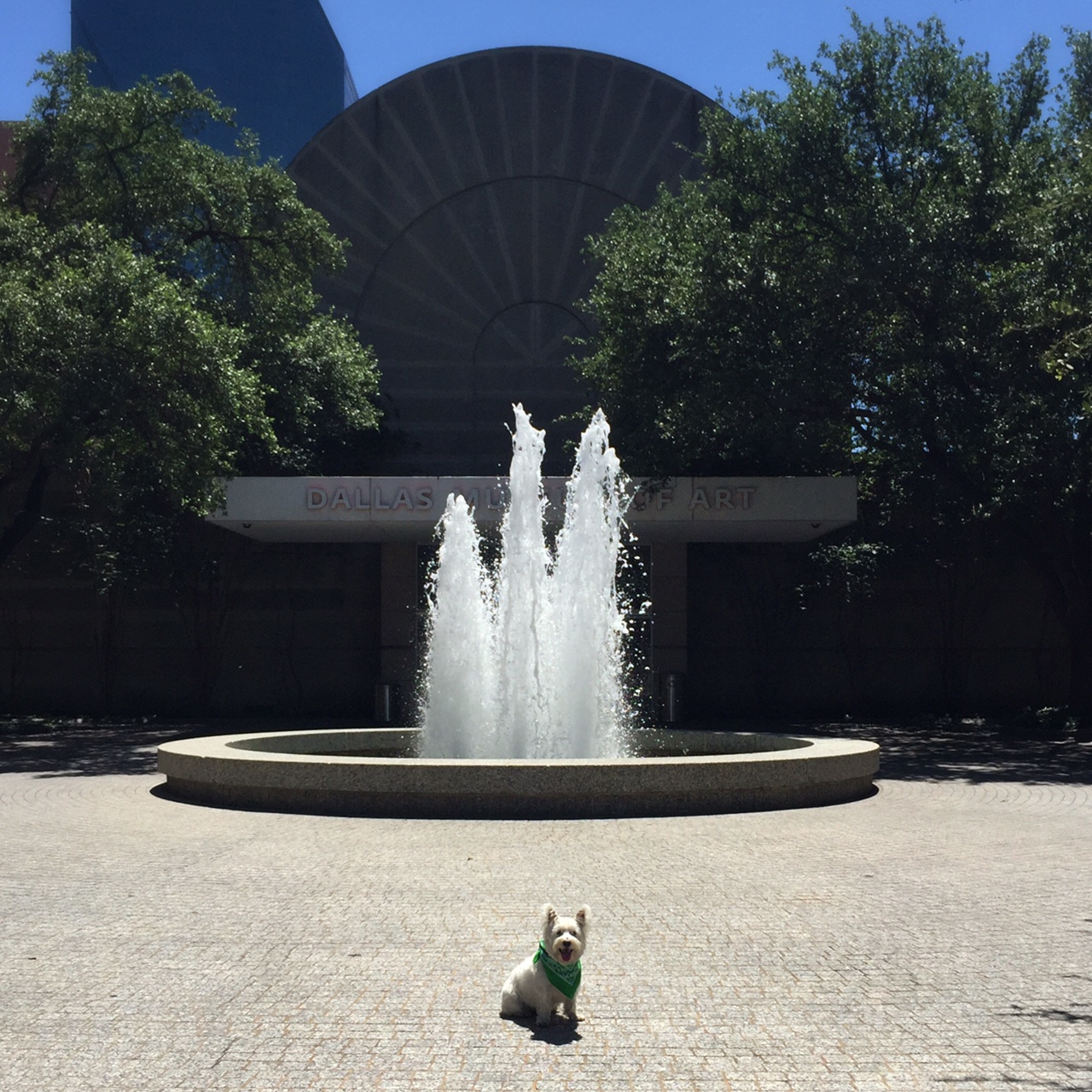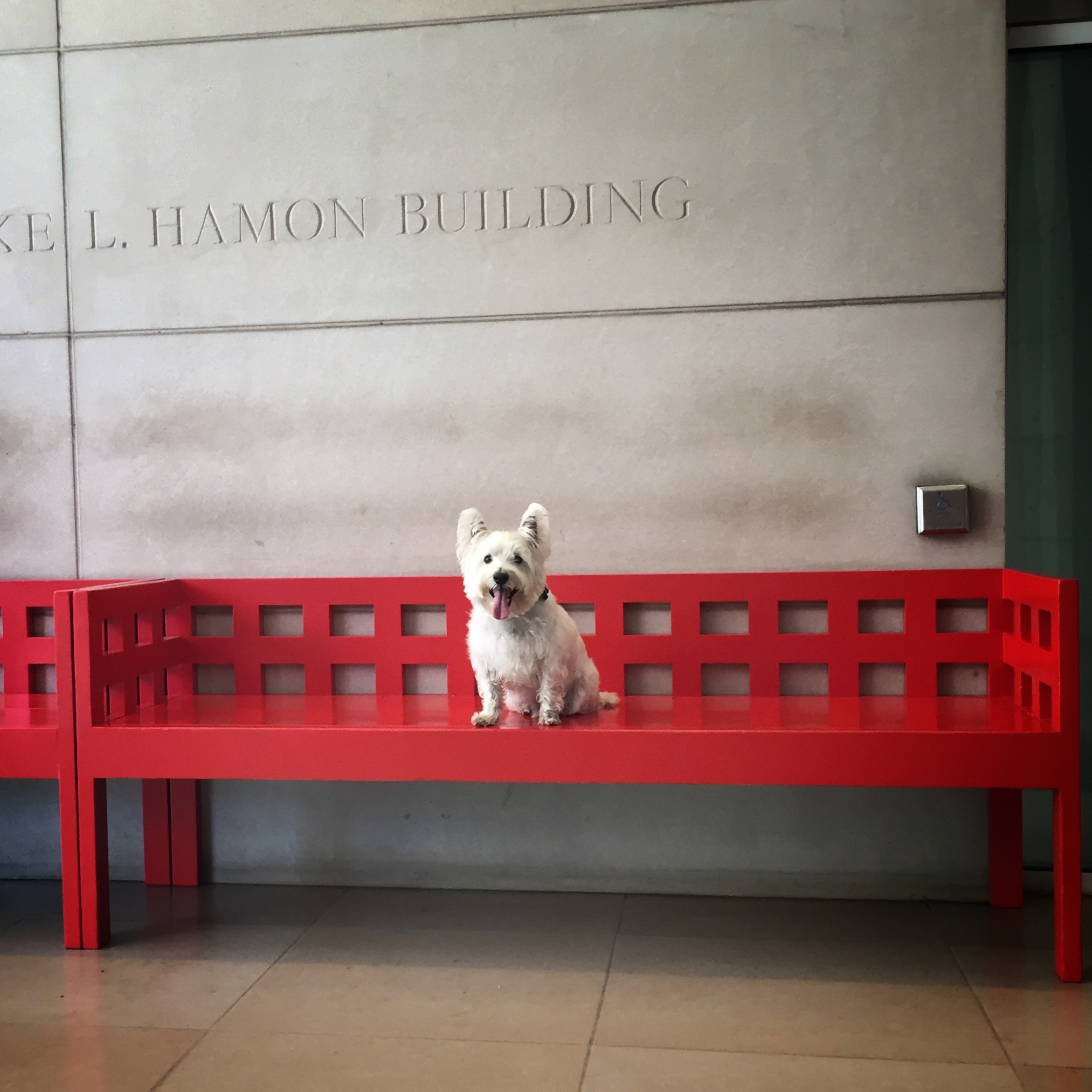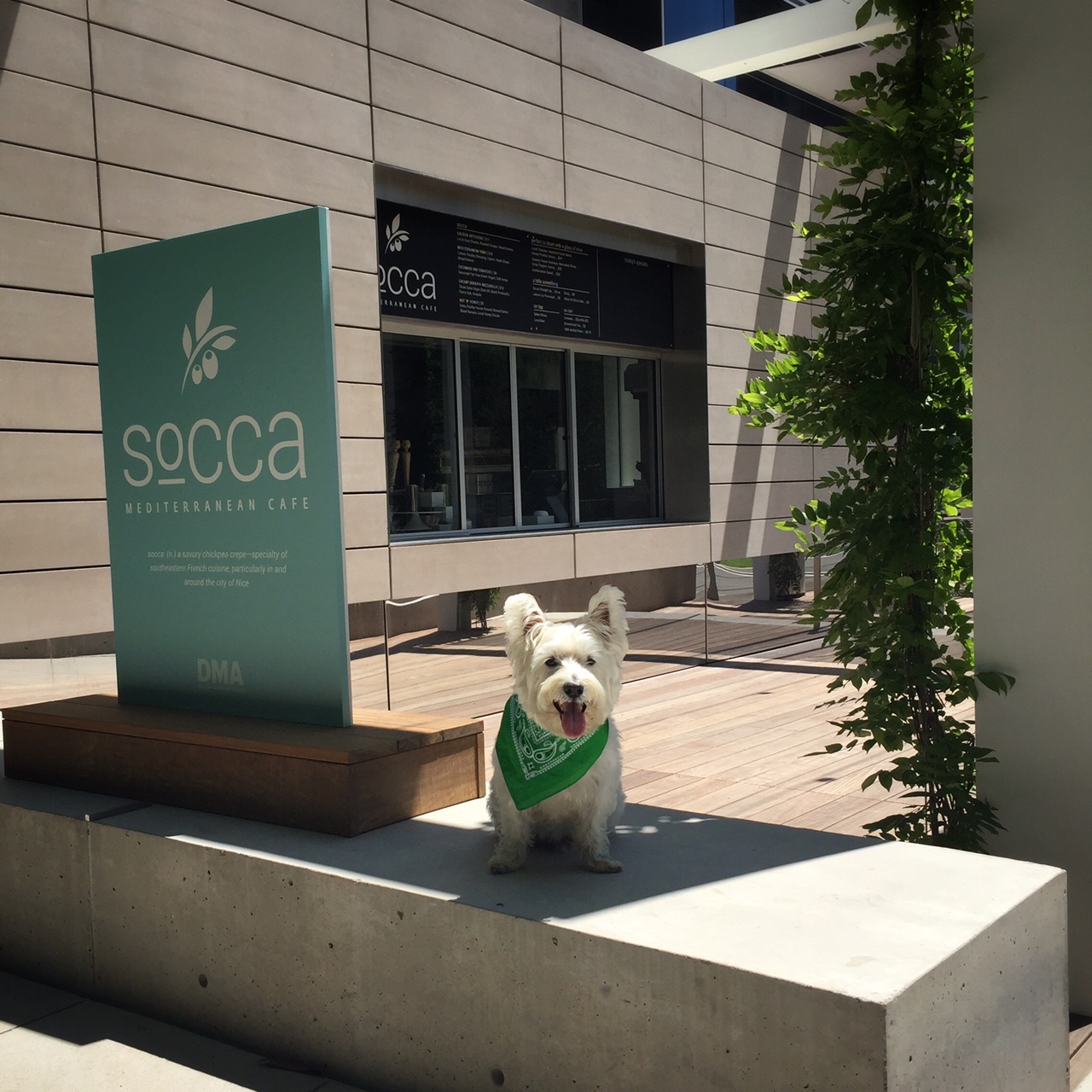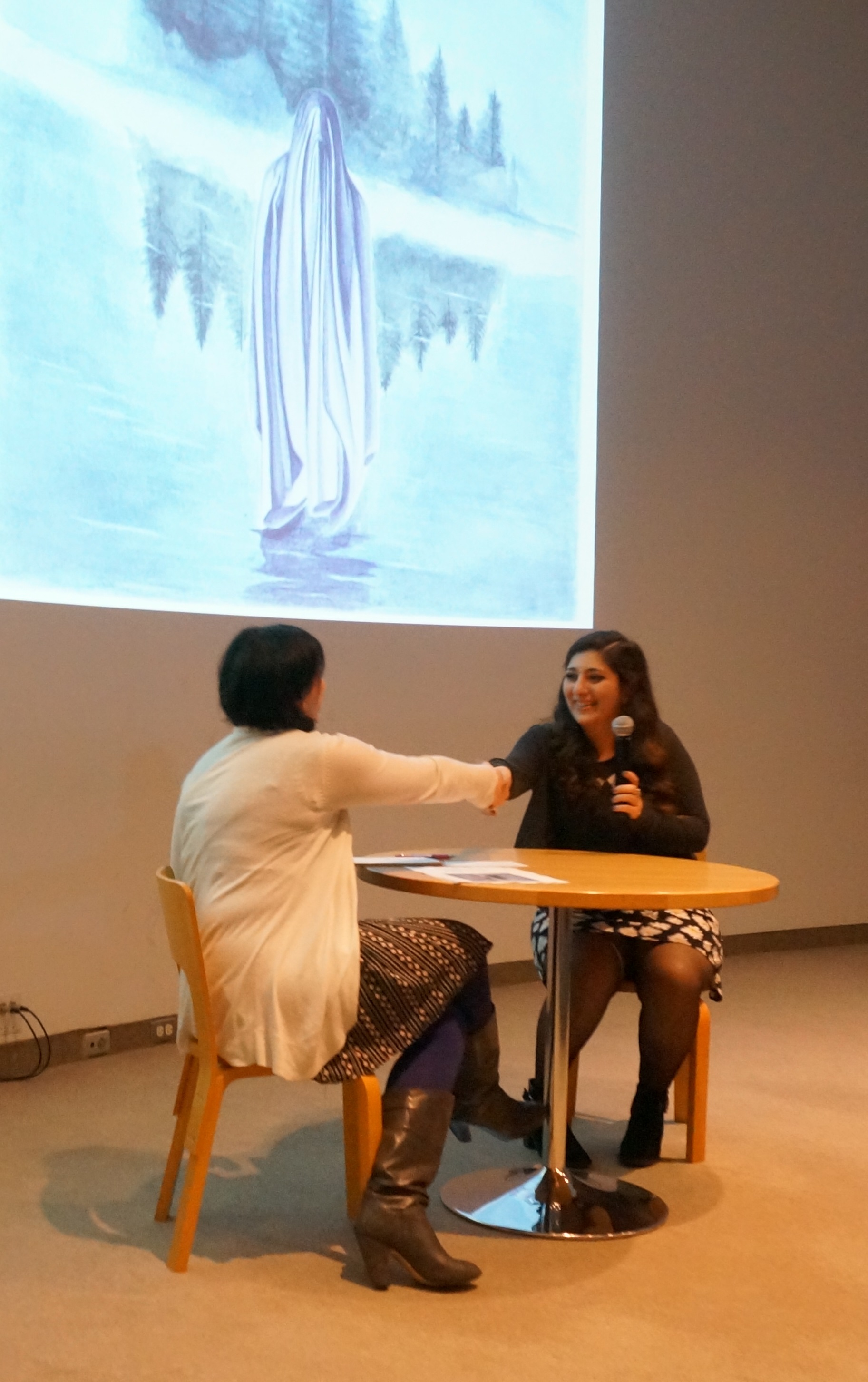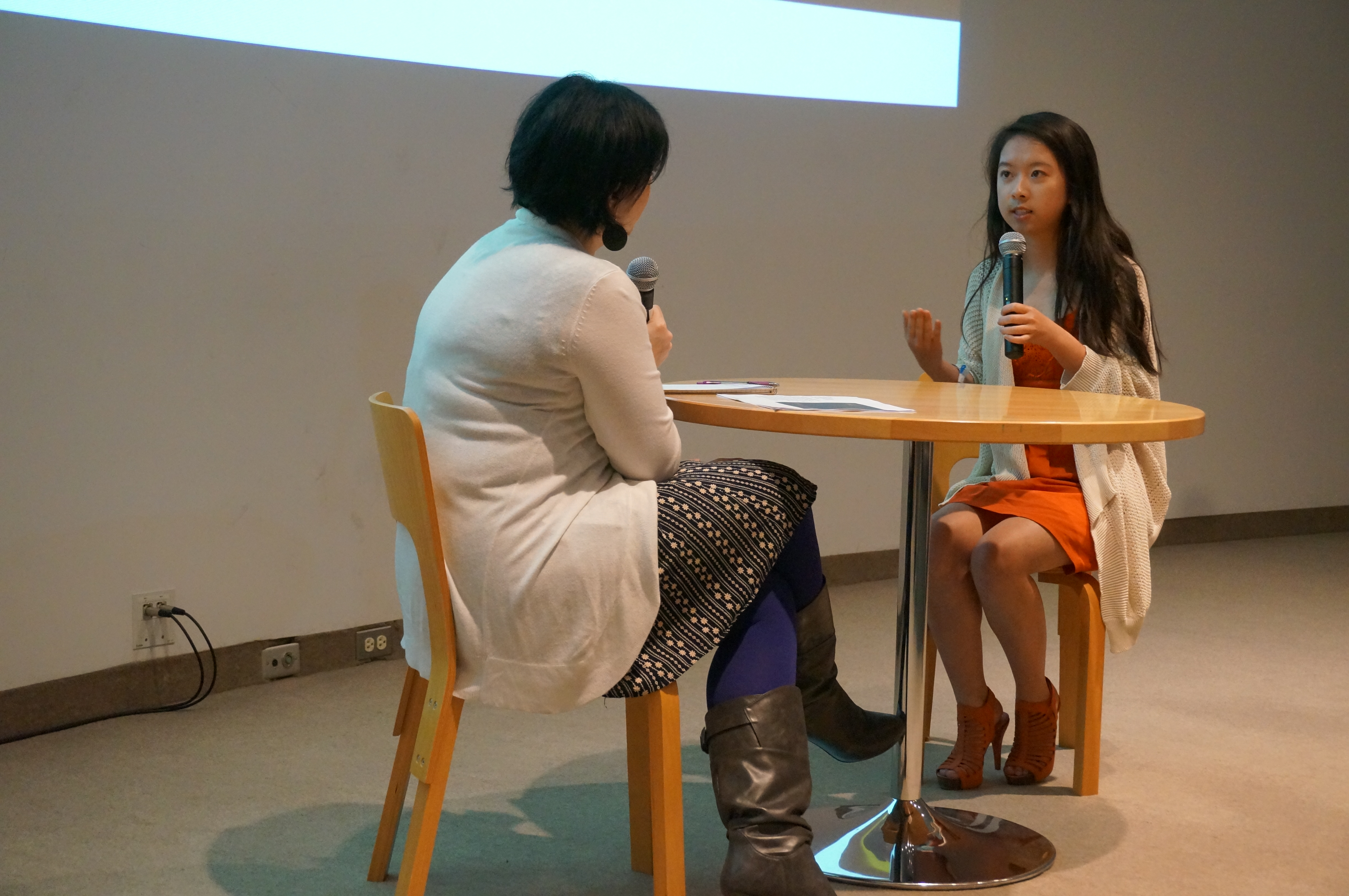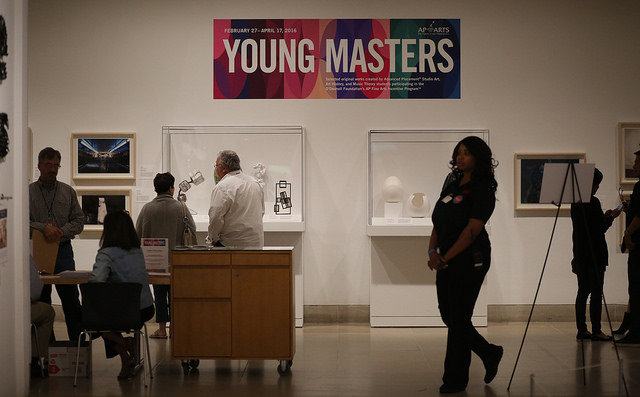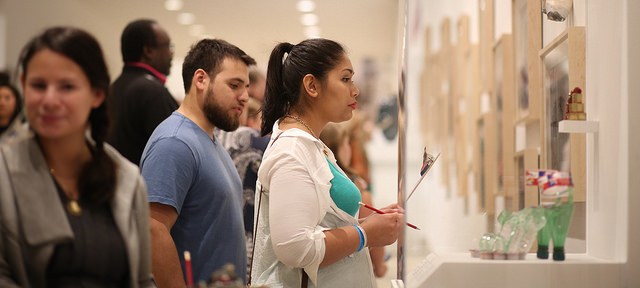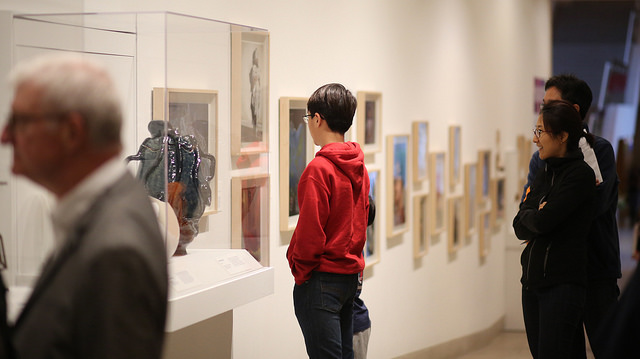We honored the opening of Spirit Lodge: Mississippian Art from Spiro with a night of artist demonstrations, performances, art making, and more. See how we celebrated at Late Night in this slideshow, and visit Spirit Lodge for free now through August 7!
Posts Tagged 'Late Night'
Late Night Recap: Celebrating “Spirit Lodge”
Published March 29, 2022 Uncategorized ClosedTags: Late Night, Spirit Lodge
Expanded for DMA Members: Late Night Recap: Celebrating “Spirit Lodge”
Published March 29, 2022 Uncategorized ClosedTags: Late Night, Spirit Lodge
We honored the opening of Spirit Lodge: Mississippian Art from Spiro with a night of artist demonstrations, performances, art making, and more. See how we celebrated at Late Night in this slideshow, and visit Spirit Lodge for free now through August 7!
The DMA Test Kitchen
Published April 19, 2017 Late Nights , Staff , Uncategorized 2 CommentsTags: Dallas Museum of Art, DMA, Late Night, Natalie Eve Garrett, The Artists’ and Writers’ Cookbook
This Friday, author, artist, and editor Natalie Eve Garrett will be here to discuss The Artists’ and Writers’ Cookbook which features intimate, funny, and heartbreaking stories paired with recipes from some of the most brilliant creative minds of our time.
And, in what has become a tradition for the Adult Programming team, we decided to try our hand at making a few of the recipes featured in the book. You can find our other cooking attempts here, here, and here.
Madeleine Fitzgerald, Audience Relations Coordinator for Programming:
I couldn’t resist choosing Alice Hoffman’s Grandmother’s Recipe for Life (also known as potato soup) for a couple of reasons. First of all, my mother’s potato soup has literal healing powers. Anytime one of my family members or friends had surgery, my mother and I would make the Famous Magical Potato Soup and by morning you would miraculously feel better. I knew going into this that nothing would beat my own mother’s recipe, not even Alice Hoffman’s grandmother’s recipe. There’s no way this soup could be more magical than my mother’s. Even if it’s from the writer of Practical Magic.
This recipe called for very few ingredients, and three of them were garlic, onion, and leeks. Nothing compliments potatoes better than onions and garlic! Also, any recipe that calls for wine is a friend of mine.
First you chop the trifecta of the onion family. It’s important to spend a sold 5 minutes admiring and photographing the geometric shape and bright green color of the leeks.
In a heavy saucepan, melt an entire stick of butter, the onion, lots of garlic, and leeks and cook until soft and starting to caramelize.
While you stir for about 10-15 minutes, open the wine early and pour yourself a glass (especially in a cute DMA wine glass!).
Then chop up the potatoes and toss them in as well. The recipe said to sauté for 7 minutes, but I wanted them to get some brown crispy spots on them before adding in the liquid (caramelization equals flavor!), so I actually let them cook for about 20 minutes before adding chicken stock, wine, salt, and lots of pepper. I poured a second glass of wine here.
The recipe does not tell you how long to cook the soup once you add the liquid. The last step is literally “Hope for the best.” I cooked it for about 20 more minutes until potatoes were cooked through and the starches in the potatoes naturally thickened the soup.
I garnished with some homegrown chives and more pepper (and maybe another splash or two of wine). I liked the soup just fine, but it needed more than just potatoes and onions.
Things I Learned: Next time I’ll add a lot more veggies: corn, peas, carrots, and even chicken or bacon. This soup was very creamy, even without any actual milk, cream, or cheese, which my mom uses heavily in her recipe. And this is why, for me, my mom’s recipe will always be better than Alice Hoffman’s grandmother’s.
Stacey Lizotte, Head of Adult Programming and Multimedia Services:
I decided to make the Kentucky Pizza because I am always on the lookout for a new pizza crust recipe and I was curious what zucchini and squash would add, texture-wise, to a pizza.
When I have made pizza dough before, the recipes usually call for you to let the dough rest for two hours, giving the yeast time to do its job. This recipe calls for a 24 hour resting period. So I made the dough on a Saturday in preparation for a Sunday pizza dinner.
This recipe also mentioned using a pizza stone – and while I normally make my pizzas on a sheet pan I thought I would treat myself to a pizza stone and a pizza sheet (used to transfer your pizza to and from the hot stone).
After preparing all my ingredients – shredding the smoked mozzarella and cooking the vegetables – I assembled my pizza on the pizza sheet.
I used plenty of corn meal and flour on the pizza sheet to make sure it wouldn’t stick and could slide right off on to the hot stone…but apparently I did not use enough. As I ended up with this:
Needless to say, my Sunday pizza dinner ended up being this:
Things I learned: When you are trying out a new kitchen tool, like a pizza stone, you maybe should do a few test runs before trying a recipe that will be featured on a blog.
Jessie Frazier, Manager of Adult Programming:
I’ve always found it kind of magical when a recipe makes strange ingredients tasty, so the editor’s own contribution to the cookbook, Disgustingly Good Cookies, caught my eye.
The recipe begins with chickpeas, drained, dried, and chopped in a food processor until they form a fluffy and surprisingly dough-like consistency. I added peanut butter, honey, vanilla, banana, and baking powder to the mix and finished it off with dark chocolate chips. I’m ashamed to say I was not brave enough to try the raw dough.
After scooping gobs of dough onto a cookie sheet and pressing them with a fork, I topped each cookie with a pinch of sea salt and put them into a 350 degree oven for about 13 minutes.
The flavor is nutty, oaty, just sweet enough, and thankfully not reminiscent of chickpeas. The texture is more akin to no-bake energy bites than crispy, ooey gooey cookies. These are not the indulgent cookies that I would eat while binge-watching Netflix. They are the ones I would put in my gym bag for a boost of energy before spin class, if I went to spin class.
Things I Learned: I still want to eat real cookies. But I’m glad to add this trick to my repertoire.
Katie Cooke, Manager of Adult Programming:
I was drawn to Francesca Lia Block’s Apple “Betty” recipe at first because I would be able to eat baked apples and call it work. And second, because of the beautiful, but sad poem that went along with it. The early stanzas call for white tapers, a crystal, and a plastic horse. I hope everyone will be okay with my substitutions of white tea candles and a tuxedo cat.
This recipe is about as simple as it gets, all I needed was flour, rolled oats, brown sugar, butter, and 4 apples. I’m always happy with a recipe that calls for things that I already have in my pantry.
You combine all the dry ingredients together in a bowl, easy enough. And then I went to work peeling the 4 gala apples. The recipe called for sweet or tart apples. I honestly do not know what the best apple is for baking, but gala apples are usually pretty sweet, so I chose them! After peeling the apples I cut them into quarters and pared them. To be honest, I think I may have cut them a little thinner than I should, but they were all uniform and isn’t that what really matters in the end? I’m going to tell myself, yes.
After all that cutting you throw the apples in the buttered pie pan. You melt the “cube of butter”, that is all it said in the recipe, so I used my best judgment. You melt it and mix that into the dry ingredients and then scoop it evenly onto the apples. I covered the pie pan with foil and baked it for 15 minutes then removed the foil and baked it for half an hour. It smelled amazing while it baked, 10 out of 10 for smell alone.
The first reaction I had was that the topping was good, but that was probably due to the clumps of warm, brown sugar. I wanted there to be cinnamon or nutmeg, some other flavor to really bring out the apple’s sweetness. But, for a recipe that I could make pretty much any day, at a moment’s notice, AND have Blue Bell ice cream, I was a happy camper.
Things I learned: Warm, baked apples should still count as a serving of fruit, even when there’s ice cream involved. Also, it’s great when a recipe is simple, but expect the taste to be on the simple side.
Please join us on Friday, April 21 at 7:00 p.m. to hear Natalie Eve Garrett discuss The Artists’ and Writers’ Cookbook: A Collection of Stories with Recipes.
Once Upon a Time at the DMA
Published March 14, 2017 Art & Teaching , Just for Fun ClosedTags: Art and Nature, fairy tales, games, Late Night, quiz
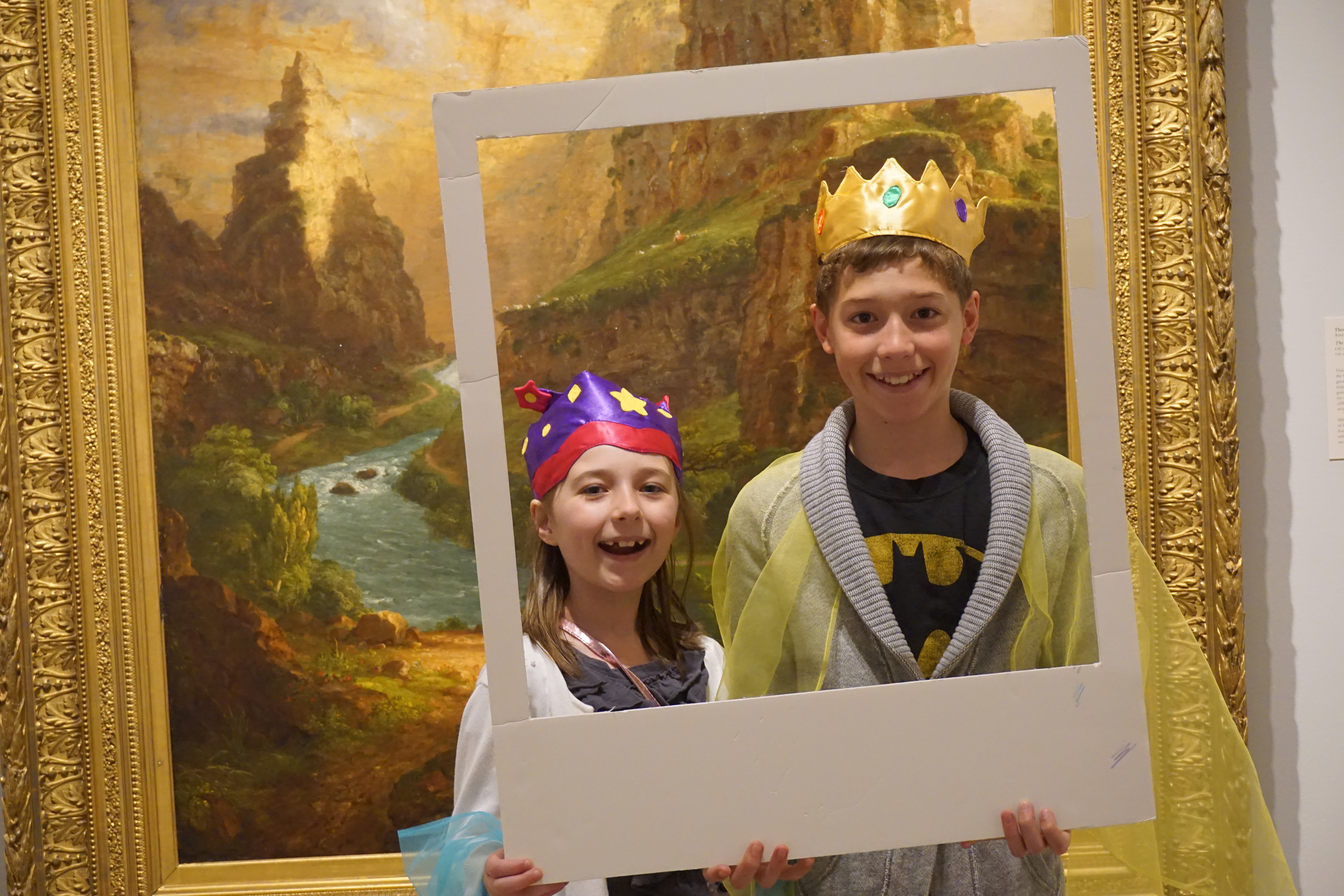
“Once upon a time” is one of my favorite phrases—it almost always precedes a magical beginning, the possibility of slightly harrowing adventures, a lesson or two learned, new friends, and a “happily ever after.” I’m not afraid to admit, I’m a sucker for any ole fairy tale!
As we’ve been exploring Art and Nature in the Middle Ages over the past few months, I’ve found plenty of fairy tale inspiration in the art. From stained glass windows I imagine would have fit in just fine in Sleeping Beauty’s castle to beautifully illustrated manuscripts that Belle would surely be found reading in the library, this medieval art has the same fairy tale magic as the stories.
Are you a fairy tale fan too? Even after we say goodbye to Art and Nature, there are still plenty works of art in the DMA’s collection that speak to a fairy-tale loving heart. To find the perfect match for your inner fairy tale hero, take our quiz here!
And be sure to come to this Friday’s Late Night, which will be filled with medieval magic and fairy tale wonder!
Leah Hanson
Manager of Family and Early Learning Programs
2016 in a Flash
Published December 28, 2016 Behind-the-Scenes , Collections , Education , Late Nights ClosedTags: Agustín Arteaga, Art and Nature in the Middle Ages, Center for Creative Connections, Dallas Museum of Art, DMA, Eagle Family Plaza, Jackson Pollock: Blind Spots, Late Night
It’s been a busy year at the DMA. From the opening of Eagle Family Plaza to the hiring of Dr. Agustín Arteaga, the new Eugene McDermott Director, my cameras have not taken a break! Now, I get that this is pictures of the year, but before we get to the photos, let’s run some numbers (Because who doesn’t love math when you’re trying to look at pictures).
Since January 5, 2016, I’ve photographed between 140-150 assignments. After a quick scan of all my folders from 2016 and some elementary-school-level math, my approximate total for photos taken this year is give-or-take 20,000.
With a little help from accounting, factoring that we work about 260 days a year, that’s an average of 77 photos every day. It’s also about 150 gigabytes of data for our computer savvy audience.
Clearly, a small fraction of the frames I take actually end up being used for our publications, ads, blogs, and more, but still, that’s a lot! In those 20,000 photos are celebrities, artists, politicians, dignitaries, and of course our amazing visitors. But, as corny as it may sound, nothing makes my day more than taking a photo of a group of kids creating art in the C3, a new mom holding her baby in the Young Learners gallery, or someone with their eyes glued to a painting in the DMA’s galleries.
These images range from some of the most momentous occasions we’ve had in 2016, to some fun behind-the-scenes moments and even just some of my personal favorites. Either way, I can’t wait for the next 20,000.
- Photos from the DISD Vision Impairment Tour. Images taken on Monday, June 20, 2016.
- Photos from Arts & Letter’s Live, featuring Mary Karr & Mary-Louise Parker. Images taken on Monday, Jan. 11, 2016.
- Photographs of the May 2016 DMA Naturalization ceremony. Images taken on Monday, May 23, 2016.
- Photos of Olivier Meslay’s farewell BBQ. Images taken from Monday, July 11, 2016.
- Photos from A&LL Presents: Rainn Wilson at the Horchow Auditorium. Images taken Saturday, March 19, 2016.
- Photos from the installation of Rebecca Warren sculpture at the North Entrance of the DMA. Images taken Friday, March 4, 2016.
- Photos from Vocalosity, held at McFarlin Memorial Auditorium at SMU. Images taken on Thursday, March 3, 2016.
- Photographs of Agustín Arteaga, Eugene McDermott Director of the Dallas Museum of Art. Images taken on Thursday, August 4, 2016.
- Photos from the Dance for Parkinson’s Disease access program. Images taken on Friday, Jan. 7, 2015.
- Photos from the DMA’s January 2016 Birthday Late Night on Friday, Jan. 15, 2016.
Greg Castillo is the Multimedia Producer at the DMA
Whiskered Deities
Published October 5, 2016 Artifacts , Education , Exhibitions , Late Nights , Members 1 CommentTags: Brooklyn Museum, cats, Dallas Museum of Art, Divine Felines: Cats of Ancient Egypt, DMA, dogs, Egypt, Kittens, Late Night, spotify
Cats are invading the DMA beginning this Sunday, October 9, when the Museum opens the nationally touring exhibition Divine Felines: Cats of Ancient Egypt. The exhibition features 80 objects from the world-renowned Egyptian collection of the Brooklyn Museum depicting cats and lions in ancient Egyptian mythology, kingship, and everyday life (and a few dogs too).
Below is an interview with DMA curator and avid cat-lover Dr. Anne Bromberg that was first published in the DMA Member magazine Artifacts. Mark your calendars for a cat-tastic night on Friday, October 21, during a special Late Night celebrating all things cat and Egypt. Listen to the purrrfect soundtrack to understand why cats are the Furry Conquerors of Culture, and follow the DMA on Spotify.
What are you most excited to present in this exhibition?
The ancient Egyptians were superb artists. Or perhaps one should say they were wealthy enough that they could afford to pay artists generously. The other interesting aspect is that for the Egyptians, cats were very important as divinities, as well as fun and delightful in ordinary life. I’ve said this to practically everybody, but cats have the closest brains to primates, or us, monkeys!
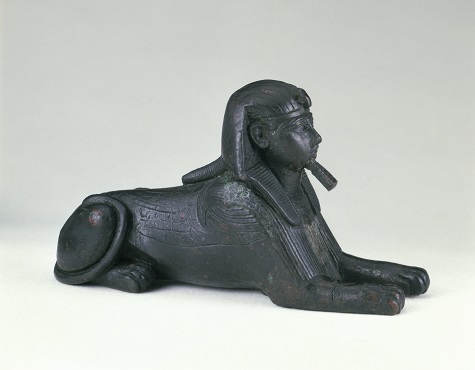
Sphinx of King Sheshenq, Egypt, Third Intermediate Period, c. 945–718 B.C.E., bronze, Brooklyn Museum, Charles Edwin Wilbour Fund, 33.586
Many people associate the ancient Egyptians with death or funerary rituals.
That’s partly because tombs were substantially built, so they survived. It’s clear from tomb paintings that the homes of the ancient Egyptians were equally glamorous, but almost none of that has survived.
What did this glamorous life look like?
They had beautiful clothes and were well fed. Furnishings of the everyday, as well as ritual objects, were exquisitely made. I’m sure they had trashy junk (because everyone does) but the impression you have is that the objects people lived with were really beautiful. The Egyptians believed that after death you could live forever in the land of eternal life. Part of the appeal of all Egyptian art, and certainly of this show, is that you see art made by people who believed you could take it with you.
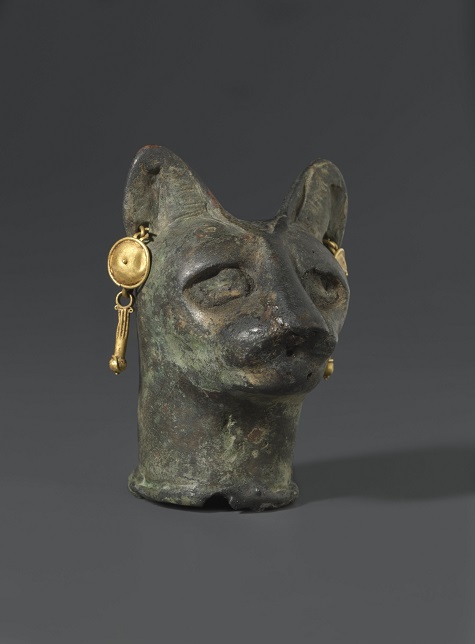
Cat’s Head, Egypt, Roman Period, 30 B.C.E.-3rd century C.E., bronze and gold, Brooklyn Museum, Charles Edwin Wilbour Fund, 36.114
It’s impressive that the ancient Egyptian civilization lasted so long.
They were isolated to some degree, and they had a foolproof source of food with the Nile River. They were also extremely literate. People who conquered Egypt knew they were taking over one of the most sophisticated cultures in their world, so they allowed that culture to continue. This many-thousand-year continuity of culture did not disappear until the coming of the Christians, who were opposed to traditional Egyptian religious ideas.
Does any part of that culture persist today?
Something that has continued unabated from prehistoric times and up until today is the passion for cats. It is still a very pro-cat civilization.
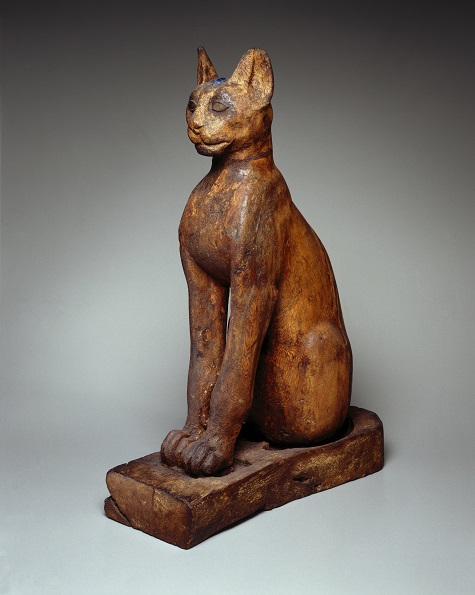
Figure of a Cat, Egypt, Ptolemaic Period-Roman Period, 305 B.C.E.–1st century C.E., wood (sycamore fig), gilded gesso, bronze,rock crystal, and glass, Brooklyn Museum, Charles Edwin Wilbour Fund, 37.1945E
Kimberly Daniell is the Senior Manager of Communications, Public Affairs, and Social Media Strategy at the DMA.
Party in the DMA
Published August 31, 2016 Behind-the-Scenes , Exhibitions ClosedTags: Dallas Museum of Art, DMA, Late Night, mural, Nicolas Party, Nicolas Party: Pathway, Street Art
On August 1, Nicolas Party hopped off the plane at DFW and ever since it has been a Party in the DMA. It only took the Swiss artist two weeks to transform the Museum’s Concourse into an enchantingly surreal landscape. Unconfined to a static sketch, each day the former graffiti artist added richly hued flora that simultaneously recalls forest floors and ocean depths. Visitors were entranced as he worked to bring his imaginative vision of a sanctuary for the people of Dallas to life. Check out the progression of the site-specific mural below.
And tomorrow, let the long weekend begin. Come experience the wonder of Nicolas Party: Pathway on Thursday evening and throw your hands up because we’ll be playing your song when DJ Wild in the Streets takes over the DMA patio. You’ll be nodding your head like yeah as we start the weekend early with 20% off crepes from Socca, fresh retro pop, funk, soul, and great company. See you there!
- Photos of Nicolas Party in action
[youtube https://www.youtube.com/watch?v=H8nUu7NnnIM]
Julie Henley is the Communications and Marketing Coordinator at the DMA.
Friday Photos: DOGgone Good Times
Published June 17, 2016 Friday Photos 4 CommentsTags: Dallas dogs, DMA dogs, dogs, dogs of instagram, Late Night, westie
Today’s post is from George Costanza Blake, a spunky Westie who belongs to DMA staffer, Amanda.
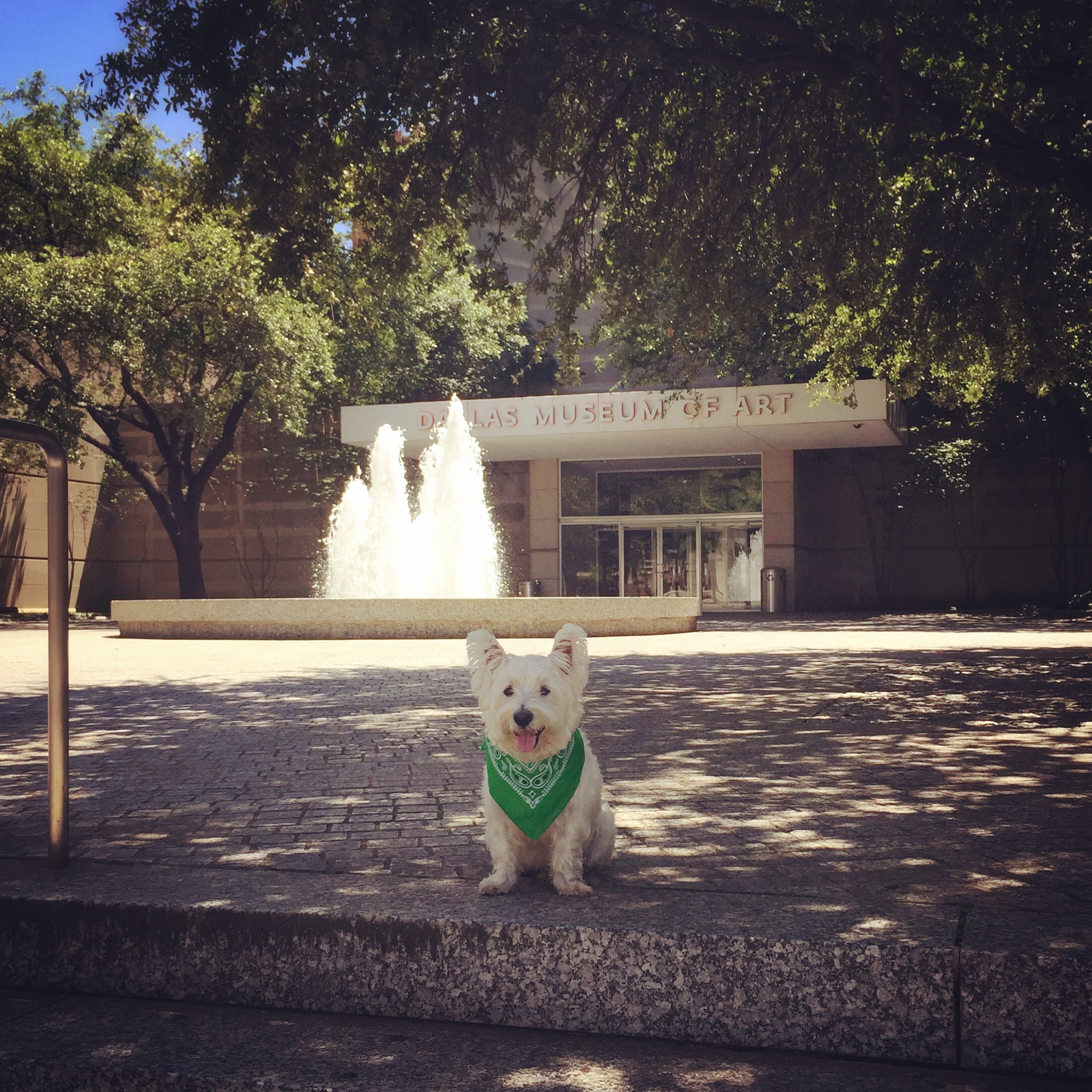
Howdy, y’all! I’m so excited to write my second blog post for this fantastic blog. Even though I still haven’t been invited to go inside the DMA to see where my human spends her days away from me, it’s still such a doggone fun place to visit and tromp around outside.
Especially now, since they have a fancy, new outdoor patio cafe that is…dog-friendly! I love going with my family to eat at dog-friendly spots. The outdoor cafe is called Socca and is named after the type of grub it serves – which is a chickpea crepe made PAWpular in southern France, where it is a specialty. Tres chic! The PAWsome thing about Socca, is that it is healthy; humans can add tuna, chicken, lettuce, and my ultimate fave – cheese. Great news for us mutts as we patiently await food dropping from tables. Well behaved dogs on leashes are welcome on the Socca patio – woohoo!
- Ready to eat!
- I love this place!
- Socca-ing up some rays.
- Can you find me?
Encompassing Socca is the brand new Eagle Family Plaza, which is a relaxing spot full of lush grass on which to lounge and a fantastic commissioned sculpture called Pas de Deux (Plaza Monument) by British artist Rebecca Warren, which I thoroughly enjoyed gazing up at to admire.
If the new cafe isn’t exciting enough, guess what the Late Night theme is tonight? It’s all about us: four-legged furry family members! If you’ve been working like a dog all week, bring your muttly crew for a evening of fun. Although canine companions aren’t allowed inside the DMA, humans can celebrate the PAWsomeness with pup-focused films (one of my faves, Best in Show – you can’t beat the Terrier Song), to animal-themed tours, live music, and scavenger hunts, it’ll be a PAWsitively rip-roarin’ good time.
I hope to see you rompin’ around the grass-filled surroundings of the DMA soon!
Until next time,

George Costanza Blake
Canine Museum Consultant
Interviews with Young Masters
Published April 5, 2016 Community Connection ClosedTags: Art, Community, high school students, Interview, Late Night, School, student artwork, students, teens, Young Masters
It isn’t every day that we’re able to peek into the minds behind the artworks on view at the DMA. Earlier this month, KERA announcer Shelley Kenneavy interviewed some of the teens whose work is currently on display in the concourse as part of the 2016 Young Masters exhibition. The students gave us a bit of insight into their sources of inspiration—ranging from the Star Wars musical score to insecurities about personal appearances—and shared their hopes as future artists, engineers, art historians, and musicians.
- Shelley interviewing Ani
- Shelley interviewing Jierui
- Shelley interviewing Austin
This year’s exhibition features sixty works selected from 858 submissions by AP Fine Arts students from ten local area high schools. Sponsored by the O’Donnell Foundation and on view through April 17, the exhibit includes forty-nine 2D and 3D works of art created by AP Studio Art students, five essays analyzing works of art in the DMA’s permanent collections by AP Art History students, and six original compositions by AP Music Theory students. The essays and compositions can be heard through the DMA’s mobile site here.
One of this year’s participating students is Allison Li, whose piece is titled Passing Tranquility. I first met Allison when she began volunteering at the Center for Creative Connections earlier this year, and was thrilled to see her digital photography installed as part of the Young Masters exhibition. To learn a bit more about the exhibition from the student’s perspective, I asked Allison a few questions about her influences, challenges, and takeaways as a 2016 Young Master.

Allison Li, Passing Tranquility, Coppell High School
Who are some of the artists you admire? What draws you to their work?
I admire many artists, some include Monet, Nguan, Sachin Teng, and many more. Many of the artists I like, I found online through their various social media accounts. I’m mainly drawn to artist’s works because of the color they use in their pieces, especially Monet and Nguan; I really like the pastel and light colors they use for their pieces. Also, the subject matter of what artists portray in their pieces is a big factor.
How would you describe your creative process? What is most challenging about creating work? What is most rewarding?
My creative process usually starts with a vague idea or concept in which I try to define it more in detail in my own head before I put anything on paper. Drawing ideas or sketches sometimes helps me better visualize what I want in a piece. After coming up with an idea, I will usually figure out what materials I need and how I want to create the artwork. I think the most challenging and most important part of creating art is coming up with the idea. It usually takes me a very long time to come up with ideas that I like and exactly how I want to execute the idea. I think the most rewarding part of this process is either having an idea you feel confident in or the final piece; both feel rewarding depending on the outcome.
What motivated you to submit your artwork for consideration in the Young Masters exhibition?
My art teacher at school informed us of this opportunity and gave us class time to create a piece to submit to the exhibition. My mom also really encouraged me to pursue my passion for art and thought it would be great and an honor if I was in the Young Masters exhibition.
Your work in the exhibition, Passing Tranquility, invites viewers to consider moments of peace in otherwise hectic environments. Where do you find tranquility in today’s fast-paced atmosphere?
I find the most peace when I am at home and don’t have homework to do. Those times are the most relaxing as I don’t have any lingering tasks that need to be done right away, and instead I get to enjoy my free time.
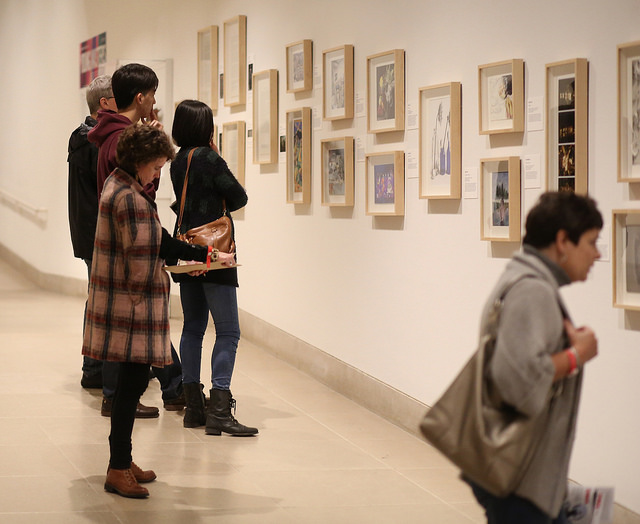
How does participating in Young Masters change the way you approach other art exhibitions as a visitor?
After going to the DMA and seeing my artwork hung up on the Museum’s walls with other great pieces, I felt very humbled and amazed that my piece was up there. Now seeing other artworks in the Museum makes me have much more respect for all the artists that are in museums.
Do you see yourself continuing to make artwork like Passing Tranquility in the future?
I am actually making similar pieces to Passing Tranquility as it is part of my concentration that I am doing for my AP 2D Design class right now. This piece was actually the first piece in a series of twelve works that I am creating for my portfolio.
What advice do you have for other young artists?
I think that the best thing to do as a young artist is to keep practicing and try not to get too discouraged if things don’t always go as planned. I believe practicing will definitely pay off in the future and seeing the improvement you have made over the years will be very rewarding. I also think that seeing other artists and artwork besides your own is important; I look at many artworks online created by various artists that post their work on social media, such as Instagram or Twitter.
- Young Masters at March Late Night
- Voting for the People’s Choice Award
- Young Masters at March Late Night
If you’re curious about what some of the other Young Masters have to say about their experience, don’t miss the second round of interviews with the teens at the upcoming Late Night on April 15. For a blast from the past, check out the video recordings of previous Young Masters interviews.
We can’t wait to see what Allison and the other Young Masters create next! Cast your ballot in the People’s Choice Award at the April Late Night to vote for your favorite studio art, art history, and music theory work in the Young Masters exhibition.
Paulina Lopez
McDermott Graduate Intern for Visitor Engagement
TAC-kling the Future
Published February 16, 2016 People 5 CommentsTags: Late Night, Teen Advisory Council, teens, volunteers
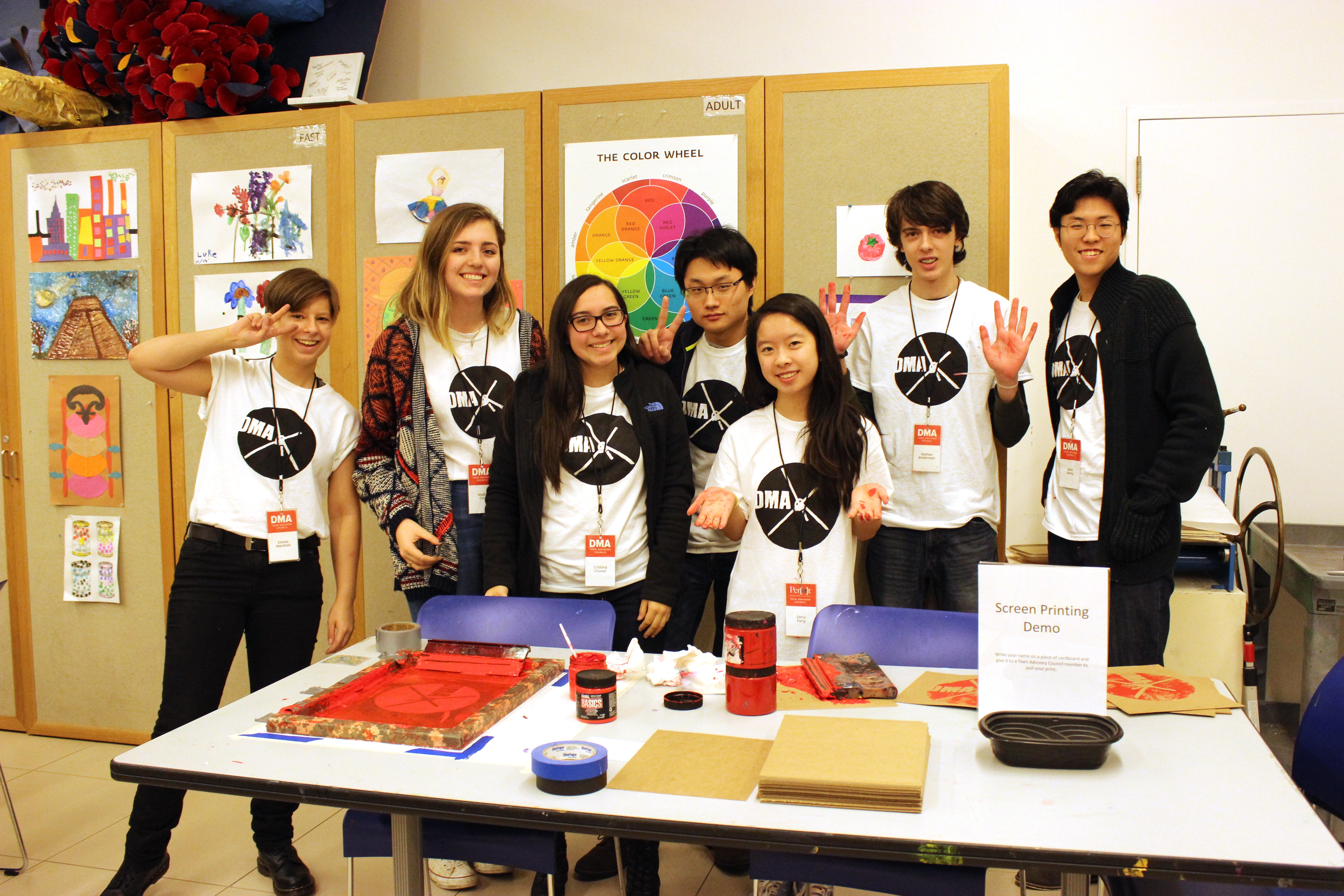
The Teen Advisory Council (or TAC for short!) was created to extend engagement and involve the teen perspective in creating new artistic experiences for visitors. We currently have fourteen members: Shirui, Won, Mo, Emma, Nathen, Carson, Maddi, Christina, Bethany, Taylor, Claire, Nikki, Riya, and me, Jierui. Our mentor, Jessica Thompson, is the Manager of Teen and Gallery Programs at the DMA.
Founded in 2014, the TAC has been involved in a variety of endeavors at first with JC Bigornia at the helm. On our first project, we partnered with the Perot Museum of Nature and Science and artist Brittany Ransom to create a window panel mural celebrating the fusion of the arts and sciences. The mural featured a tableau of microscopic views of everyday objects.

Our next stop was a partnership with Big Thought through their City of Learning program with the goal of preventing summer education loss. In a series of Turn Up events, our booth created a My Dallas Is… board (inspired by the Before I Die Wall) to better understand our fellow residents’ perspectives on our city. Later, Eliel Jones, a former McDermott intern, engaged us in his Experiments on Public Space project. The resulting Alternative Signage performance art piece used cardboard signs to break the barriers between the public and the Museum.

The June 2015 Late Night marked our biggest involvement with the Museum as we planned tours, haiku slams, scavenger hunts, speaker talks, and other superhero themed activities. Lastly, our most recent January Late Night Creations workshop with Jessica returned to our interest in the intersection of the arts and sciences. We used LED lights in conjunction with batteries to illuminate beloved works of art from the DMA’s permanent collection.
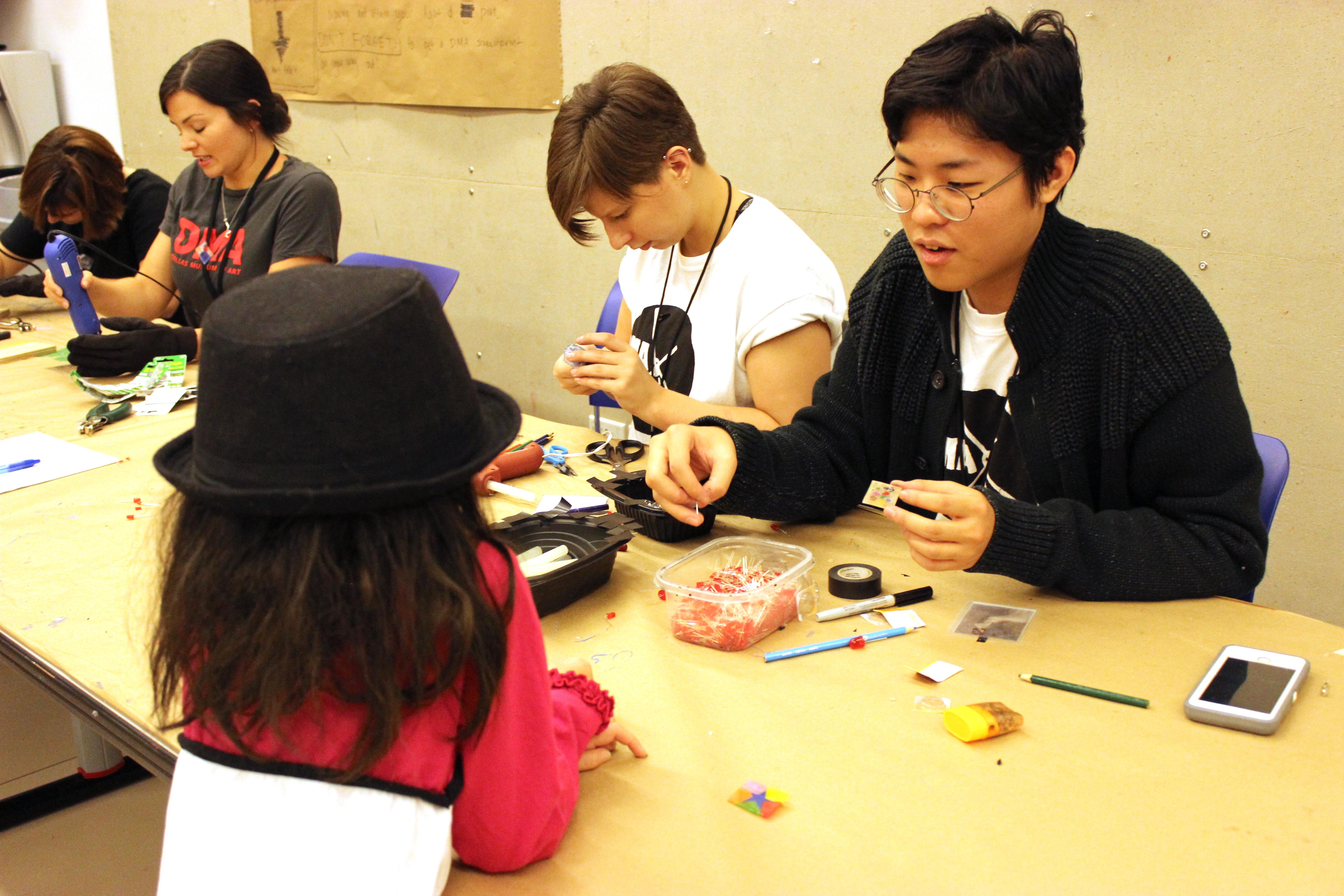
So what’s in store for the TAC? Your next chance to hear from us–after reading our lovely introduction to the blogosphere–is at our February Late Night Creations workshop entitled Rest On Your Laurels on February 19th. Join us as we celebrate your individual virtues and vices in the spirit of Classical tradition! We are also in the process of planning a teen workshop and other programs in the community. Although we may be relatively young, we are excited to add our mark to the vibrant canvas of the DMA!
Until next time!
Jierui Fang
Teen Advisory Council member
